 Cartoon Bob in his native habitat.
Cartoon Bob in his native habitat.Loading...

Issue 114
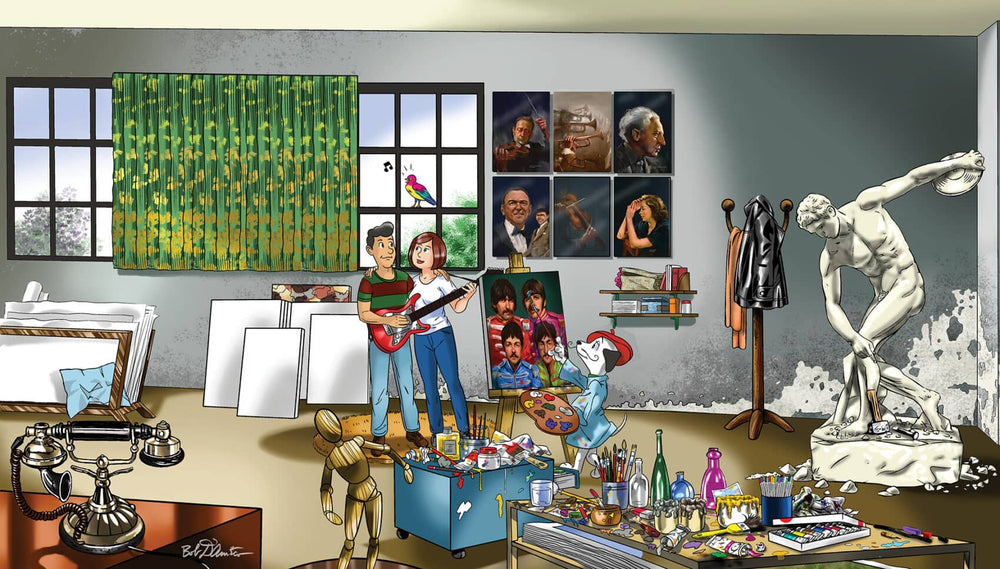
They're Back!
 Cartoon Bob in his native habitat.
Cartoon Bob in his native habitat.


Dion: Blues With Friends
The first album I ever bought with my own money was Presenting Dion and the Belmonts (Laurie LLP 1002). In faded red ink from a rubber stamp, you can barely make out the name of the store at which I bought it, Steinway Sports & Records in Astoria, Queens. As its name suggested, it sold athletic equipment (basketballs, baseball gloves) on one side of the store, and singles and LPs on the other side. Everything the 11 year old me loved in one store front. If I had been older (say, 12), I might have dropped out of school to work there, just for the employee discount.
It was a great choice for an album, because Dion and the Belmonts, from the other side of the Triboro Bridge in the Bronx, were an exceptionally versatile group blessed with the-then unappreciated musical intelligence of its leader, Dion DiMucci. Instead of just one hit single and the rest filler, as most albums were circa 1959, Presenting was a sure thing because it contained five top 40 hit singles: the explosive street corner doo-wop “I Wonder Why,” which introduced Dion and the Belmonts with a bass-to-falsetto bang in 1958; the classic Rodgers and Hart ballad “Where or When” (updated from the 1937 musical “Babes in Arms”), Doc Pomus and Mort Shuman’s “A Teenager in Love,” and two songs of teenage angst, “No One Knows” and “Don’t Pity Me,” which sounded blue to me.
And the filler wasn’t bad: “You Better Not Do That,” a 1954 country hit for Tommy Collins, verified Dion’s long stated fondness for country music: Collins’ version is as down home and twangy as country music could get in the 1950s, which was pretty twangy indeed. [Version with Buck Owens here]
Then there was “I Got the Blues.” Dick Clark writes in the liner notes that “I Got the Blues” is “a lowdown bluesy number on which Dion ‘growls out’ a lover’s lament.” (Why Clark put “growls out” in quotations remains a mystery.)
This blues “growler” was written by Ernie Maresca, who wrote or co-wrote the swaggering hits “Runaround Sue” and “The Wanderer” that would establish Dion’s career as possibly the most significant solo rocker after Elvis and BTB (Before the Beatles). That run of hits from 1960 – 1963 also included Dion putting his own stamp on Leiber and Stoller’s “Ruby Baby,” a 1956 R&B hit for the Drifters.
So Blues With Friends is nothing new for Dion, who will be 81 in July. The most remarkable thing is the facility of his singing, the groove and tone not sounding a day over 65, about the age Dion was when he recorded the first of three 21st century blues albums. The other is that it is entirely self-written, most of the songs co-written with Dion’s longtime collaborator Mike Aquilina, a prolific Catholic historian and theologian. Aquilina co-wrote the 2011 autobiographical Dion: The Wanderer Talks Truth, which details the singer’s fierce embrace of his Catholic roots. Most of the songs on 2012’s Tank Full of Blues were also DiMucci-Aquilina originals.
They make a good team on Blues With Friends, which drew immediate attention (as this is written, it is No. 1 on the Billboard Blues Albums chart), because of the guitar rock hall of famers and sterling newcomers who populate the record at Dion’s invitation. There’s Joe Bonamassa, with a crisp and concise power surge, on “Blues Comin’ On.” Bonamassa and his manager Roy Weisman started the label that released the Dion album, Keeping the Blues Alive Records. Other ace guest shots include Billy Gibbons’ topspin on “Bam Bang Boom,” and “Can’t Start Over Again,” a kind of soul ballad somewhere between Delbert McClinton and Percy Sledge, featuring Jeff Beck.
There is outstanding slide guitar on a few tracks: “Told You Once in August” succeeds so well at evoking an Appalachian feel that you forget that it’s a new song, and not from the ghost holler repertory of obscure 78 RPMs. The slide playing features John Hammond coming through one speaker, Rory Block the other.
“I Got the Cure,” featuring the slide guitar of Sonny Landreth, has some of that old school Dion swagger. Both the playing and writing show real discipline. When Dion sings “I’m the drug you need,” he’s taking on the machismo pose that made him king of the New York streets. With more than 50 years of sobriety, tapes and CDs of Dion’s spiritual talks are valued in the recovery community, and it would be easy for “I Got the Cure” to wander into an ode to the almighty. But you admire Dion’s subtlety in letting the listener choose how to interpret the disease and the cure, and he keeps it real by sticking with the language of the blues.
There is a direct line to heaven for the last song, “Hymn to Him,” with Patti Scialfa singing and Bruce Springsteen on guitar. It’s a new version of a song Dion recorded on his 1987 gospel album, Velvet and Steel. “Uptown No. 7,” with a flashy Brian Setzer on guitar, is in the train’s-bound-for-glory subgenre, and it is absolutely fitting that even after all these years Dion has lived in South Florida, the “train bound for heaven” is a subway.
“Song for Sam Cooke (Here in America)” also stands alone from the all-star blues package. Paul Simon sings harmony on this unexpectedly timely song about Dion being on the road on a touring package with Cooke in 1962, both at a peak of stardom. Dion, who was seeing the world but not yet experiencing it, was not ready for the hostility that would greet them, the sting of segregation, when the tour hit the South, in Memphis. They could not have a meal together in a restaurant, or stay in the same hotels. “The places I could stay/they all made you walk away,” he sings.
Most of the guest star turns were done remotely, built by co-producer Wayne Hood around Dion’s voice and guitar. According to Hood, Dion sent polite emails to a number of musicians he thought would be right for the album. “People wrote back the sweetest emails saying what an honor it was to be asked to play on a Dion album,” Hood said in an exchange on Facebook Messenger. “It was crazy exciting! Dion would email the guest artist an mp3 of the song with a bit of backstory. Most of the songs were pretty much worked out arrangement-wise, with a full rhythm track. There was never any real guidance or suggestions as to what to play or sing. It was just, ‘play something cool and take a solo at 2:43.’” It plainly helped that Hood is also a versatile musician, who played guitars, pass, electric piano, Hammond organ and drums.
Some artists did multiple versions of their work. “Sometimes I’d might get 10 or more audio tracks for me to sync up to the main session,” Hood said. “It was never a problem getting the new, overdubbed tracks to line up. All the engineers were real pros and made it easy. Since the tracks I sent were Dion’s ‘keeper’ vocals and acoustic guitar the artists were listening to…his phrasings and dynamics, is one of the things that made this album so exciting.”
Even Bob Dylan chipped in with liner notes. They’re both amusing and imbued with idiosyncratic truth that Dylan so often conveys in his prose: “You have to be careful with the blues. They’re strong with lust and you can overpay for them, but they quote the law…. He’s got some friends here to help him out, some true luminaries. But in the end it’s Dion by himself alone, and that masterful voice of his.”
Dylan calls it like you hear it. All these “luminaries” add their own little garnish, but the main course is still the power, the distinctiveness, and flow of Dion’s voice. At nearly 81, its power remains undiminished. He’s got the heart of a Saturday night, and the soul of Sunday morning.
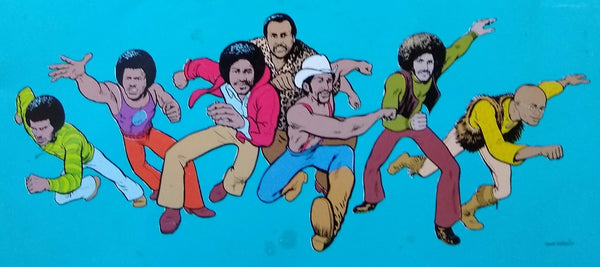
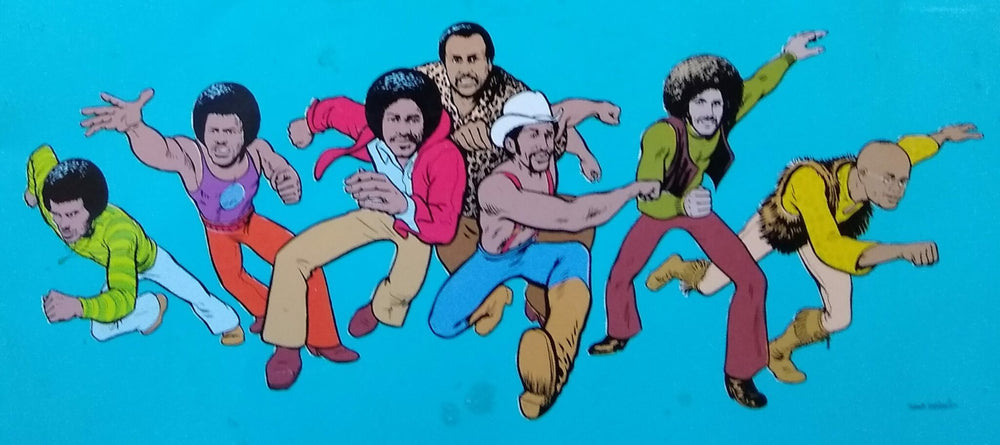
More Time with War: Lasting Impact
I am watching Midnight Blue on leased-access cable channel J. It is Saturday morning just past midnight and I am enjoying a shot of tequila in my apartment on 3rd Avenue in the Murray Hill section of Manhattan. I just finished a long tour and now I am home. I have eight weeks free before my next road commitment. It’s 1977.
The phone rings and a vaguely familiar voice says, “Kenny?” Yes, it be me” I say. “It’s Jimmy Grant,” the voice says. “Jeezuz H…big friggin Jim Grant?” I almost shouted into the telephone. It has been over a year since the last time I have seen him. New Year’s Eve to be exact. “What is going on, big guy?” “Well, I have just been made the manager of War. That is impressive as they are a big group now.” (They had just had two number one singles, “Slippin’ Into Darkness” and “The Cisco Kid” in a row and a platinum album; they have exploded.
“Kenny, I need you to finish the tour for me. I can’t stay on the road. There are only six weeks of the tour left. I got to get back to LA and open a new office and set studio time for their next LP. The money is good and the per diem is outrageous. Can you meet me in Athens, Georgia? Tomorrow?” “You betcha,” I answer. “Our travel agent will issue you a ticket. It will be at the counter.”
Early the next afternoon I knock on Big Jim’s hotel room’s door. The door swings open and Jim embraces me in a bear hug. After pleasantries, he points to the second bed and motions for me to sit. “We have a lot of work to do,” he said. “I am flying out tonight,” he says, hands me a beer and…we go over the tour, contacts, travel arrangements and other details. By now it is late in the day and Jimmy must catch his plane and I must get over to the hall where War is playing for the soundcheck.

The cover of a War 1973 concert tour program.
I drop him at the airport and, keeping his rental car, drive to the coliseum. I know the band and most of the crew; they are expecting me. I walk my circuit touching all the bases (box office, sound mixer, dressing room, crew, and inspect the stage) and then visit the opening act’s dressing room. The opener is Wet Willie.
If you did not know why, you would think they were an unusual choice for an opener, but we were in Phil Walden country and we had to give homage to him. Phil was the boss of Capricorn records, located in Macon, Georgia. With acts like the Allman Brothers and the Marshall Tucker Band, Phil was a music business mogul. Phil starting booking R&B acts in the 1950s and became Otis Redding’s manager till Otis’s death in 1967. He also represented Sam and Dave, Al Green and Percy Sledge to name a few. Wet Willie is a really good Southern rock band from Mobile, Alabama and had recently had a top ten single, “Keep on Smilin’.” I meet the band, including band member Donna Hall. Oh yeah! Our eyes clicked and I knew we would be dating. Her two brothers were also in the band.

That night the concert was great, and War was impressive. I remembered back to the Wishbone Ash tour I had done previously, when Eric Burdon(of the Animals) was War’s lead singer. They band was quite different now that they morphed into a legit headline act. The next night’s show was in Macon in a coliseum with a capacity of about sixteen to nineteen thousand.
Only a thousand people showed up.
What the hell is going on? War has been selling out everywhere; this is unexpected, unreal. I racked my brain – why, how, what? I was stumped and could not figure it out or explain it away.
I get a call from Jim Kellem at CMA, the booking agency. They think they know why. A miniseries on television called Roots has taken over America by storm and everyone is staying home and watching it. For those who weren’t around then, Roots was based on the novel Roots: the Saga of an American Family by Alex Haley, a story about main character Kunta Kinte, his enslavement, and his descendants and their eventual emancipation. LeVar Burton played Kunta Kinte. Roots was one of the most popular shows in American TV history.
Being on the road, we would not know this as we are in our own world. The agent told me to forget about the box office tonight. Everyone is gonna take a hit.
This how the business works with big promotors and major agencies. They protect each other, they have worked together yesterday, today and will again tomorrow. New acts and smaller agencies do not nearly have those kinds of relationships. The monies are smaller, and promoters are more fly by night. Some newer promoters are one and done. They just lack experience and have no relationships or haven’t been around long enough to establish themselves.

An aside: on the upper end of the concert business, things are quite different, for example. When the Rolling Stones go on tour, they use just one promoter for the whole tour. Most of the top echelon acts work this way. It is just smarter and better with more continuity. If a mistake is made it gets corrected and never happens again. On the other hand, when you work with different promoters (even good ones) there is an element of reinventing the wheel for each concert. It is difficult enough (for all touring acts) playing different venues each night. Unless you experience them [or read Ken’s articles in Copper! – Ed.] one could never conceive the range of different types of problems.
When it comes to the Rolling Stones Mick Jagger is the man on point. They have an agency, but that is just for housekeeping, issuing contracts, and doing the nuts and bolts of the deal and all the follow-up work. The story goes, Mick is negotiating with Bill Graham for their next world tour. Mick says, “we want a 90/10 split after expenses.” (Expenses are facility rental, security, catering, advertising, union stagehands and such.) Bill Graham says “I’m not going make that much money with that deal; can we do better? Bill Graham Presents is one of the top concert promoters in the world.”
Bill notes that the organization has successfully presented thousands of concerts and festivals, and they’re an encyclopedia of experience, savvy, and know-how. That’s gotta be worth something to the Stones. Mick allegedly answers, “yes, I know, you are one of the best promoters out there, but there are a few others and Bill, there is only one Rolling Stones. Think of the prestige. Everyone knows the Stones always sell out the house. Take it or leave it.” Long story short, Bill takes it. Mick negotiates or approves all of the Rolling Stones’ business deals.

Page from a War 1973 concert tour program.
Back to the current situation. Roots is on television for about another week. The remainder of the week’s concerts are canceled. Why bother losing any more money? Minimizing everyone’s losses is the directive of the day. When Roots was over, everything went back to (good) business as usual. The shows and box office were great and soon the Roots experience, as profound as it was, faded into our rear-view mirror.
We continued to tour, working our way northward. As we did, the Ohio Players replaced Wet Willie as War’s support act. When you tour with a big group you make new friends and have good times. The tour ended in New York with War playing Shea Stadium, and I was back home.
Over the next year, I managed to be on tour in the south and I saw Donna a bunch of times. On time on the phone when I was back in New York she mentioned that Wet Willie was playing Madison Square Garden as the opening act for Mark Farner and Grand Funk Railroad.
When the time came, I called her hotel and left a message for her. She did not call back. Next day, I called again and left another message. She never called me back. Hmmm, that was weird.
A few weeks later I am talking with Jim Kellem (my buddy from CMA) and I tell him that Donna had disappeared on me. He smiled and said, ”I guess you haven’t heard. She is with Mark Farner.” Ohhhh, so that is why. Que Sera, Sera. And well, even if I am better looking and way cooler, he is a rock star and I’m just a rocker.
Fast forward about 30 years…
In 2009 I am at the Consumer Electronics Show (CES) in Las Vegas. It is the Monster Cable Blog Party for Beats headphones. We are up in the penthouse of the Paris Hotel and it is wild. Dr. Dre, Jimmy Iovine, Pharrell Williams, Lady Gaga, LeBron James among other celebrities are there – including LeVar Burton. I was there along with 120 of the most influential consumer electronics press people. We all are just mingling, hanging out and eating crab and lobster and drinking margaritas.
I spot LeVar and walk over. I introduce myself; I tell him the War story about that week in Georgia. He loves it.
He tells me that over the years many people have approached him and told him their stories of that week. It blows his mind that for so many people, that week stands out for them. In all his years in television (including Star Trek: The Next Generation, Sesame Street, and more) he has never had people react to anything like the way they did to Roots, and have such powerful memories from the show’s impact that week.
It’s a good feeling when good memories like this come back.
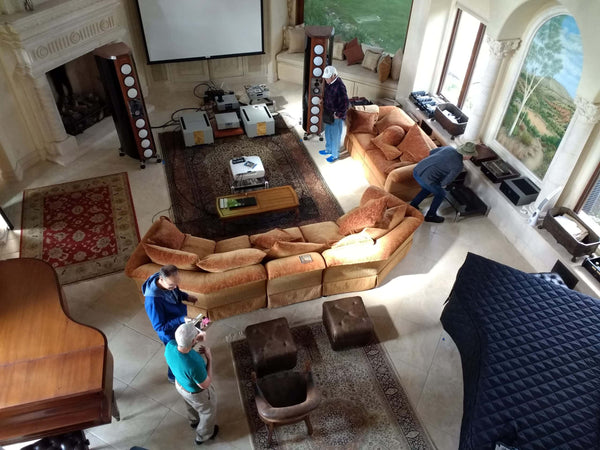
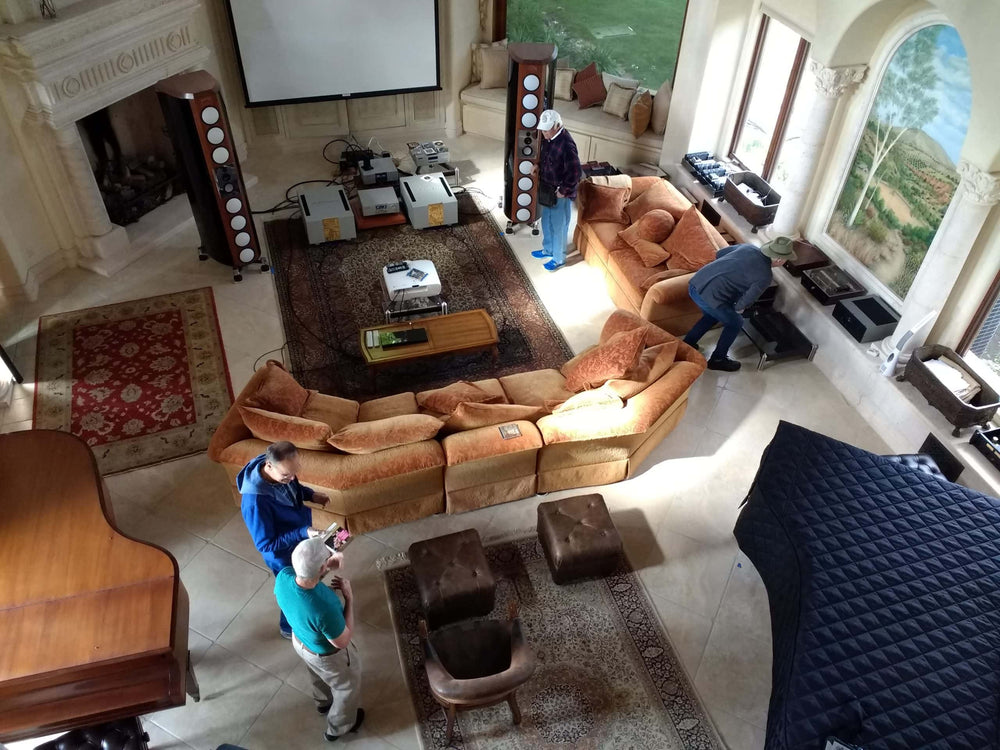
A Love Supreme
Members of the San Diego Music and Audio Guild visit a fellow member in Encinitas for music and scotch. The Marten Coltrane Supreme 2 speakers from Sweden stand almost 6 feet high. They use first-order crossovers, weigh 500 lbs. and cost as many thousand dollars. There are six 11-inch passive drivers on the rear. You might say these speakers have gravitas, especially with the EMM Labs MTRX 1500-watt amplifiers.
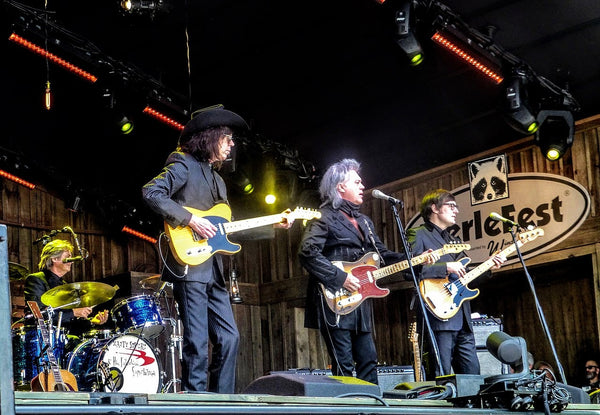
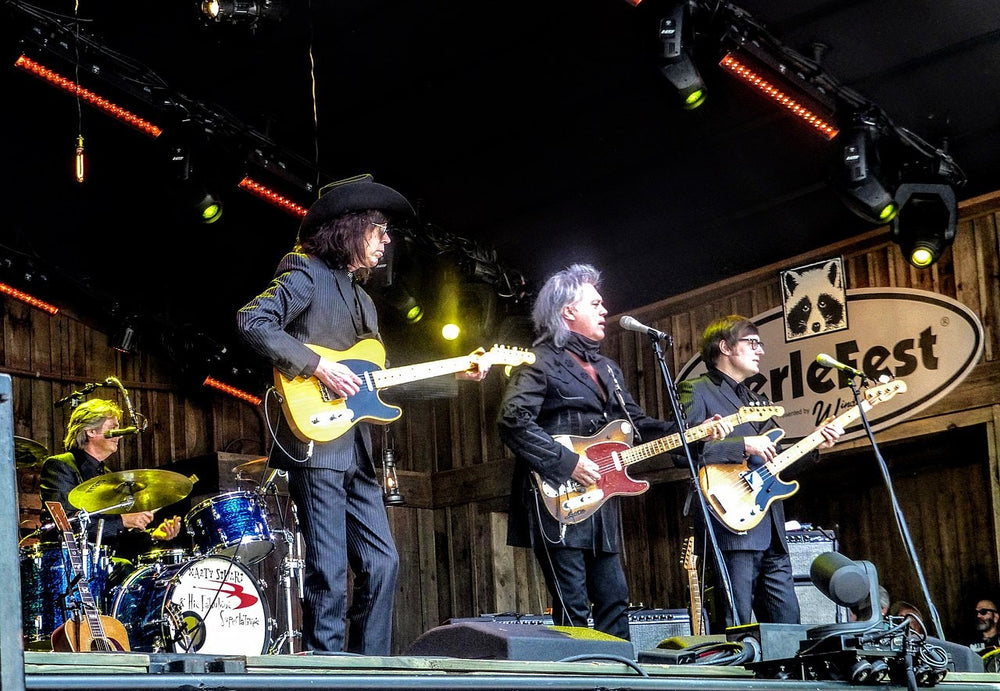
Songs of Praise from Unlikely Artists, Part Three
In Part One and Part Two of this series (Issues 112 and 113), I noted that throughout the history of American music, the influence of the Christian church has been well documented and apparent. While some bands have been working in the Christian music genre from the beginning of their careers, others haven’t been as overt, yet have written and recorded Christian-faith songs – and you might be surprised at who some of them are. Yet, as mentioned in last issue, truth can often be stranger than fiction, and the following stories prove it:
Van Morrison
One of the most obsessively private rock stars to emerge from the 1970s and to remain an active artist, Belfast, Ireland-born Van Morrison has written over a half dozen albums’ worth of songs referencing Christian beliefs and his spiritual journey. Raised as a Protestant in religiously divided Belfast, Morrison was also exposed to his mother’s Jehovah’s Witness denomination, inspiring his own experiences which were chronicled in his song, “Kingdom Hall” from Wavelength (1978).
Morrison has called himself “a Christian mystic” in interviews, and his own pursuit for enlightenment has been documented throughout his extensive song catalog. His passion for the poetry and religious imagery of William Blake and John Donne (whose poems have been incorporated into some Catholic liturgies) and his flirtations with Scientology and other religions nevertheless have found Morrison inevitably circling back to Christianity, even though he has been contradictorily quoted by journalists that, he “wouldn’t touch religion with a ten foot pole.”
Throughout his career, his songs have put his spiritual quest front and center. “If I Ever Needed Someone” from His Band and the Street Choir (1970), “In the Garden” from No Guru, No Teacher, No Method (1986) which invoked the Holy Trinity, and “When Will I Ever Learn to Live in God?” from Avalon Sunset (1989) are just a few examples.
Van Morrison’s 1989 “Whenever God Shines His Light” from Avalon Sunset reached #20 as a single on the UK charts. Recorded as a duet with UK pop star Cliff Richard, an Omnibus Press review described the song as “a testament of faith.”
“Have I Told You Lately,” which Morrison has said was composed as a prayer, would become a monster hit song for Rod Stewart in 1993.
Van Morrison’s Hymns to The Silence (1991) actually included traditional hymns, continuing the enigma about his views on religion, yet further demonstrating that his quest for enlightenment was an ongoing one. While more recent records have been comprised predominantly of jazz and R&B covers, Morrison likely will continue to surprise and mystify his audiences until he’s ready to call it quits.
Lenny Kravitz
One thing that can be said about retro rocker Lenny Kravitz – he literally wears his cross, which is unmistakably tattooed across his back. The biracial multiple Grammy Award winner is the son of a TV producer Jewish father and Bahamian-American actress mother who raised him in a neutrally religious household. The teenaged native New Yorker independently chose to become a Christian while attending high school.
Throughout his musical career, the multi-talented Kravitz (who also acts in film and TV, designs furniture, has partnered with Leica for photo exhibitions, and does residential/commercial interior design) has written and recorded songs that profess and promote his Christian faith.
One of his biggest hits, the hard rocking title track from Are You Gonna Go My Way (1993) was written from the perspective of Jesus speaking to his flock. The even more overtly Christian oriented “Believe,” couched in Beatlesque melodies, guitars, phase shifted vocals and George Martin-styled string arrangements, contains unequivocal declarations like:
The Son of God is in your face
Offering us eternal grace
If you want it you’ve got to believe
‘Cause being free is just a state of mind
On Circus (1995), Kravitz continued the Christian song themes of hope with “God Is Love”:
God is love/Through all your trials and tribulations
God is love/He’ll get you through all situations
God is love/And if you are ready He always is ready for you
“The Resurrection,” with its Jimmy Page-inspired guitars and “Kashmir”-styled dynamic build and Middle Eastern motifs, offered the fire and brimstone often found from the pulpit of the Baptist Church:
The resurrection is here to stay
That he’s coming back again
Look what he’s done to me
Now I am living in another space and time
He walked on the righteous path
To keep us from Satan’s wrath
Baptism (2004) contained a number of Christian-themed songs like “Baptized” and “Calling All Angels.” Both were slower-tempo rockers that recalled some of the soul vibe of Marvin Gaye – if he was singing with Ernie Isley or Shuggie Otis backing him on guitar.
“I’m A Believer” from Strut (2014) was a return to the hard rock Kravitz sound of his “American Woman” Guess Who cover, while his latest album, Raise Vibration (2018) invokes the funk rock of his friend Prince, with the praise song “The Majesty of Love” and repentant songs like “We Can Get It All Together”:
I thank you father
For giving me life beyond the grave
Blood is the Power
So now I don’t have to be afraid
I hear the truth, I know the taste
I read your word, I feel your grace
I need to do an about face
Right into you so we can get it all together
Lenny Kravitz continues to produce records, tour, follow his faith, and hold prayer meetings before every show. The lack of pretense, humility and genuine spiritual sincerity from this superstar is refreshingly welcome and rare among celebrities of his caliber.
Dolly Parton
If there was any American artist who could qualify to be named the next National Treasure, Dolly Parton would certainly make many judges’ short lists. Her accomplishments, ranging from writing and performing hit records, acting in films, her Dollywood amusement park, her philanthropic foundation, and her television production company, are nothing short of phenomenal.
As a singer in the 1960s best known for her duets with Porter Wagoner, Dolly Parton’s solo success was kickstarted by her compositions, which have since become standards: “Jolene” in 1973 and “I Will Always Love You” in 1974, which later became one of the late Whitney Houston’s biggest selling records. With the door opened thanks to those early successes, Parton channeled her formidable talents into crossing over to pop music, acting, returning to her bluegrass music roots, and then launching her business enterprises.
Throughout her cumulative successes, music has always been Parton’s artistic anchor. As the granddaughter of a pastor, the church has been a constant spiritual inspiration.
She has been a prolific songwriter, and the majority of songs she has written with Christian themes have been in the country or bluegrass music genres. Her “Hello God” from Halos and Horns (2002) had more of a gospel flavor to it, a sign that she was looking to push her musical boundaries within her faith-based compositions:
Written in the aftermath of the 9/11 terrorist attack, Parton described “Hello God” in an interview in Dollymania.net: “I realized just how fragile we really are, and how small life is, and how everything can change in the blink of an eye. I hope everything comes across as I meant it. It’s like everybody believes that God is their God. But God belongs to everybody.”
In 2019, Dolly Parton spoke with People magazine, stating that at age 73, she felt that God was calling her to give a ministerial message of hope through music. Deciding to reach a wider audience she made three collaborations with new artists:
- ”God Only Knows” with for KING & COUNTRY (Christian alt-rock duo from Australia)
- “There Was Jesus” with Zach Williams (Christian singer-songwriter)
- “Faith” with Galantis featuring Mr. Probz (Swedish EDM)
“God Only Knows” had previously been a hit on the Christian music charts but fortuitously, the Smallbone brothers from for KING & COUNTRY managed to get the attention of Dolly Parton and did a remix with her added vocal track. The new single cracked the Billboard 100 charts – a milestone for the Aussie duo. The song’s reassuring refrain of comfort was simpatico with the message Parton felt called to spread:
God only knows what you’ve been through
God only knows what they say about you
God only knows how it’s killing you
But there’s a kind of love that God only knows
“There Was Jesus” was written by Christian singer-songwriter Zach Williams, who also has a prison ministry and is known for his hit song “Chain Breaker.” His southern rock-influenced band is reminiscent of the Allman Brothers and Lynyrd Skynyrd. Williams and Dolly Parton performed the song at the 2019 CMA Awards.
“Faith” is a modified version of the John Hiatt song, “Have A Little Faith in Me” rearranged by Swedish DJ Galantis and sung by Dutch rapper Mr. Probz and Dolly Parton. Parton modified some parts from the original Galantis track to focus on the message elements. While EDM is a music genre far out in left field from Parton’s country base, it is not her first experiment, as she had tried her hand at dance music in the post-disco period with “Baby I’m Burning” in 1978.
Dolly Parton is a living testament to indomitable spirit, and her calling to create additional songs of faith should yield even more unusual collaborations in the future.
Marty Stuart
In 1994, producers Tony Brown and Don Was oversaw the recording and release of Country, Rhythm and Blues, a collection of duets featuring country and R&B stars demonstrating just how much the two genres actually had in common and why Nashville and Memphis were a lot closer musically than they were geographically.
Some of the pairings included Al Green and Lyle Lovett on Willie Nelson’s “Funny How Time Slips Away,” Vince Gill and Gladys Knight on the Ashford & Simpson hit “Ain’t Nothing Like the Real Thing,” and Robbie Robertson’s “The Weight” performed by The Staple Singers and Marty Stuart.
The last duet fortuitously forged a deep friendship that would motivate Marty Stuart, a multi- instrumentalist prodigy, country music star and vanguard point man for the preservation of traditional American music, to create a band dedicated to old time gospel music, the backbone of which has led to contemporary country, R&B, and rock and roll.
Wielding both the original Clarence White B-Bender Telecaster guitar used with The Byrds on their groundbreaking country rock recordings, and a Telecaster formerly owned by Roebuck “Pops” Staples (a gift), Marty Stuart led his new group, His Fabulous Superlatives, through a series of landmark recordings and concerts that have resurrected many gospel music classics. Not wanting to miss out on the fun, Stuart included The Staple Singers and other guests, such as wife Connie Smith, dobro master Josh Graves and ex-boss and former father-in-law Johnny Cash on the records and penned some new songs to add to the repertoire. The albums include:
Souls’ Chapel (2005), Live at the Ryman (2006), The Gospel Music of Marty Stuart (Live) (2014), Saturday Night/Sunday Morning (2014) and Way Out West (2017).
As every one of these albums is superb, here are just some samplings:
“99-1/2 Won’t Do” – The Gospel Music of Marty Stuart
“It’s Time to Go Home” – Souls’ Chapel
“Heaven” – Saturday Night/Sunday Morning
With trademark tremolo-laden arpeggiated guitar, plaintive lyrics and harmonies that meet at the crossroads between Africa, Appalachia and England, Marty Stuart and His Fabulous Superlatives bring the music home full circle, both thematically and sonically. The Saturday night carousing and Sunday morning piety is synonymous to the sinner/saint walk that is an inescapable part of the human condition, and many artists. The songs cover a major portion of the roots of American music.
Interviewed by the Grand Prairie Daily Herald Tribune in 2006, Stuart disclosed that although he was raised in the church, he reached a low point in his life in the early 2000s when he was arrested on a DUI. Already depressed over the recent death of his close friend and former father-in-law Johnny Cash, Stuart credited his Christian faith, bolstered by the gift of a guitar from “Pops” Staples, for inspiring his personal comeback and calling to reintroduce inspirational gospel music to the public again.
“(Making Souls’ Chapel) It was a joy, it was pure joy. I like gospel music that inspires and doesn’t point fingers or condemn. I was forced to look around at the face of gospel music and there is a difference between people who are called to do it and music that’s just product.”
As the other artists and songs listed here can evidence, truer words have never been spoken.
Header image of Marty Stuart and His Fabulous Superlatives courtesy of Wikimedia Commons/cp_thornton.


The Strokes: Indie Rock from The Big Apple
Plenty of major groups have made their name in New York City, but not many are actually made up of New Yorkers. Four of The Strokes’ five members grew up in the city. Through their exploration of garage and post-punk sounds, they helped bring about an indie rock renaissance in the Big Apple.
Singer/songwriter Julian Casablancas, guitarist Nick Valensi, bassist Nikolai Fraiture, and drummer Fabrizio Moretti were local guys who found each other at school. Although Casablancas first met guitarist Albert Hammond, Jr. in Switzerland, they started playing together seriously when Hammond moved from his native California to Manhattan to attend NYU and became Casablancas’ roommate. In 1998 the five men formed The Strokes and started gigging in popular New York clubs like the Mercury Lounge, where the manager was so impressed that he agreed to manage the band.
An immediate hit among edgy rock aficionados, The Strokes put out a promo EP, The Modern Age, and soon received competing offers for a recording contract. In 2000 they signed with RCA. Their 2001 debut album was Is This It, which came out in Europe first and was scheduled for a September drop in America. Yeah…September, 2001. Along with everything else in American life, Is This It changed because of 9-11. The release was delayed by a month, allowing the sarcastic “New York City Cops” to be replaced by the song “When It Started.”
With Casablancas as sole songwriter, the band chose an unadorned sound for this album, in hopes of establishing their distinctive musical identity. Producer Gordon Raphael, who had also worked on the EP, recorded them his basement studio, Transporterraum NYC. On “When It Started,” you get a good sense of the complicated interplay of the two guitars with Casablancas’ bright-timbred voice.
Although “New York City Cops” was removed from the CD release, the vinyl had already come out on the 11th, so the original track remained. This song shows a heavier side to their sound. That opening wave of distortion is a hint at how their interest in electronica would grow during the coming years.
Trying to up their game, the band hired Radiohead producer Nigel Godrich for their second album. It didn’t take long for them to fire him, however – either for his lack of musical soul or for his overly controlling personality, depending who you ask. So they brought Raphael back, and in 2003 they released Room on Fire. It did very well for a non-mainstream album, reaching No. 4 on the Billboard 200.
Once again, all the songs are by Casablancas. “The Way It Is” relies on a repeating riff of hard-driving chords, pushed along by Moretti’s stick work. It’s a break-up song, but furious, not sad.
Next up was First Impressions of Earth (2005). The biggest single from this album was “Juicebox,” which hit the No. 9 spot on the US Modern Rock chart. Raphael started out as producer, but Casablancas was determined to hire David Kahne, known for working with Tony Bennett and Paul McCartney. The styles of the two producers weren’t compatible, and Raphael left.
Kahne’s presence did bring about some sonic changes. On “Fear of Sleep” you’ll notice a less frantic vibe, with the various instruments blended into a wall of sound, to borrow a phrase. Casablancas’ voice is grittier, too, and he’s singing more sustained notes than usual, a style reminiscent of Radiohead’s Thom Yorke.
Another new aspect to this album is the way Casablancas has started to collaborate on the songwriting. (It’s likely this was always the case, but now his colleagues are receiving credit.) Moretti co-wrote “Evening Sun,” a melancholy lyric with an interesting, changeable melody and some nice, tight cymbal work by Moretti.
After touring their third album, The Strokes took a break for a few years. They regrouped in 2009, but things did not go smoothly in the studio. For one thing, Casablancas had decided to delay joining them, too busy finishing and promoting his first solo album. Yet he was still the lead singer and main songwriter, even if he recorded some the vocals remotely.
The band was also unhappy with their new producer, Joe Chicarelli. They brought in Gus Oberg to replace him, plus did some of the production work themselves. Making the situation trickier was Hammond’s drug problems, which landed him in rehab and out of commission. Somehow, despite all these troubles, they released the album Angles in 2011.
The biggest difference from the earlier records is the intensified use of electronic keyboard effects and MIDI. “Metabolism” not only enhances and underpins the guitar lines with synth, but also distorts Casablancas’ voice.
Critics praised the next album, Comedown Machine (2013), again produced by Oberg, for finally blending the synthesized effects with the powerful guitar sounds of Valensi and Hammond. The band also took an unusual approach to marketing. In lieu of traditional album promotions like TV appearances, they offered the single “One Way Trigger” as a free download on many platforms. It was a fairly successful experiment.
One of the album’s tracks is “Slow Animals,” credited to Casablancas, Hammond, and Valensi. The slick R&B style of the verses is a new sound for the band, maybe chosen because the lyrics deal with a girl’s sexuality, offset by her parents’ discomfort and worry. The Japanese version of the album included an up-tempo version of the same song, called “Fast Animals.” Here’s the slower one:
The Strokes then took a break to pursue individual projects, returning to occasional live performances in 2014. In 2016 they gradually started laying down some new tracks. Their latest album, their sixth, came out in April of 2020. It’s called The New Abnormal. And to think they came up with that title in 2019, before they knew just how abnormal things would get!
The album is produced by Rick Rubin, founder of American Records and co-founder of Def Jam Records, who’s been a powerhouse in the rock and hip-hop scene for decades. Under his guidance, the band has doubled down on their redefined existence as an electronica band with post-punk leanings. “Why Are Sundays So Depressing” ironically blurs and twists the relationship between guitar and synth until the blipping sounds of chiptune (an electronica style inspired by 1980s video games) seem to be created manually by picks against guitar strings.
It will be interesting to hear what’s next in The Strokes’ development.
Header image courtesy of Wikimedia Commons/Roger Woolman.
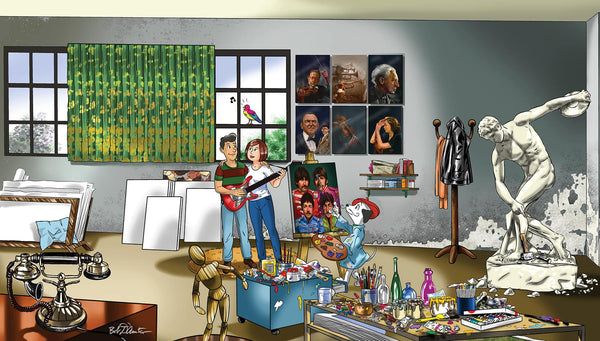
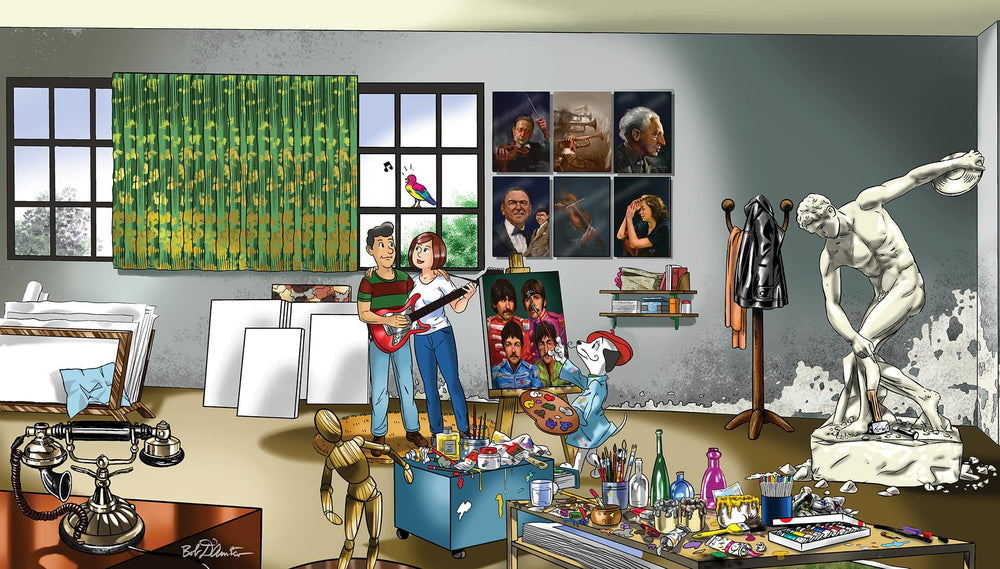
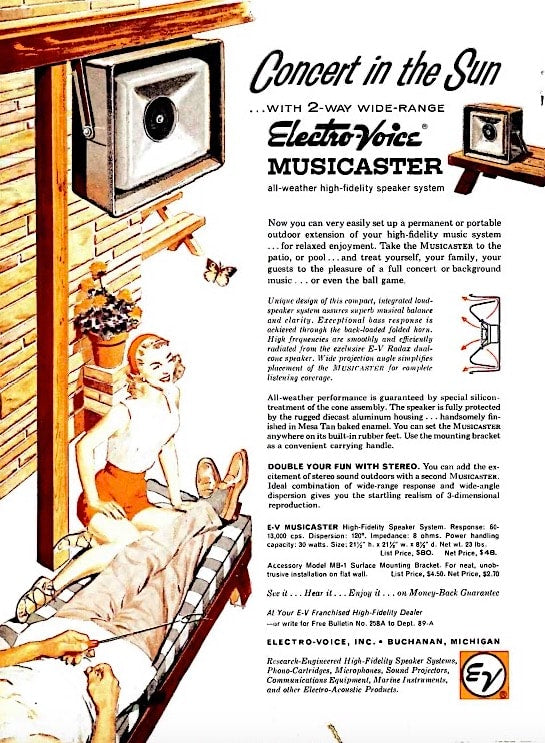
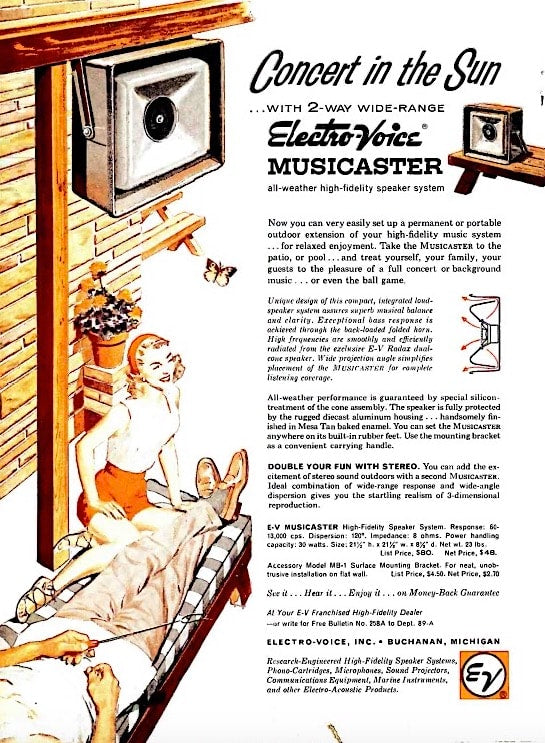
Elusive Butterfly

That butterfly isn't giving up the sweet spot. From Audio, August 1959.

Before smartphones, there were smart tape recorders. From Audio, August 1964.

And the man from downstairs was right! From Audio, January 1958.

Instead of just banging on top of your preamp the next time it acts up, read this...How to Troubleshoot and Repair Your Stereo System by Hershal Gardner, 1976.

Who says audiophiles are old? From Audio, October 1958.


A Stereo Journey
I was a kid about seven when I refused to speak.
A neighbor was the sales manager for RCA in Philly and as such, would get some of the earliest gear when it was introduced: a projection TV, color TV, and back when I was kid, a tape recorder. His son showed the tape recorder to me, babbled into the microphone then played it back. I was amazed. He told me to speak. I was too intimidated.
I have sometimes wondered if my entry into a career in radio was actually influenced by my failure to utter one word into that amazing machine.
E.J. Korvette was a big box department type store. They had cheaper Webcor tape recorders and I managed to scrape the bucks to purchase one. All I remember was that the microphone was crap, it had a cool “magic eye” record-level indicator and the recorder didn’t record. Back it went.
Fast forward to high school years (1960-64): I would visit the local stereo shop almost weekly (Soundex, in Ardmore, PA). There was always soft music playing. Many pieces of audio treasure…and a Roberts 1040 reel to reel tape recorder. I lusted for one. But I couldn’t afford it.
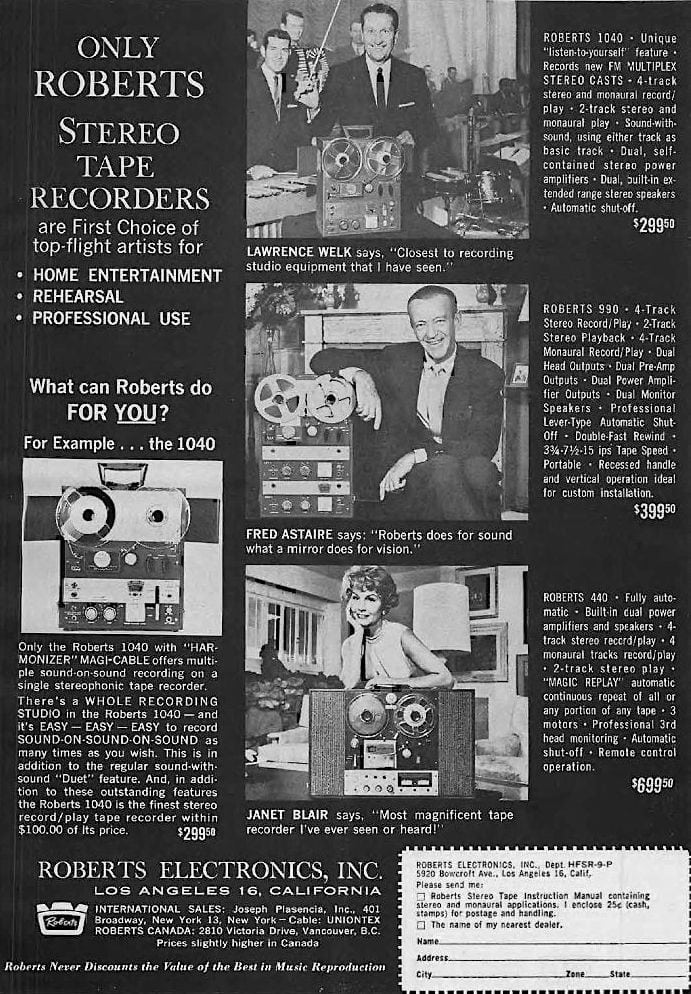 Who wouldn't want one of these? A Roberts 1040 is on the left.
Who wouldn't want one of these? A Roberts 1040 is on the left.After maybe some years of snow shoveling, lawn mowing and saving what I’d earned and from my allowance, I finally managed to buy that Roberts. It had two heads, erase and record/play, built-in speakers, and did work. I bought an Astatic microphone which at least appeared hardier and more serious than the Webcor one. I spent hours recording things like “check check test one two.”
At Korvettes I bought some prerecorded music and one tape in particular impressed me: Enoch Light and the Light Brigade. Bombastic music with a twist – I believe one channel was slightly delayed and gave a more spacious sound.
I began to lust for a three-head deck. And save. I then was able to add echo to my “check check,” thanks to the third tape head. The deck was a Roberts 1057.
I borrowed the church pulpit microphone to record a band.
I recorded a Stan Kenton concert for Armed Forces Radio.
At one time my father took me into Philadelphia to buy a birthday present, a speaker! We went into an electronics store and I purchased an open-backed 8 ohm speaker in a cheap enclosure without knowing anything that would have allowed me to make a good purchase decision. It was the kind of small PA speaker you’d see in classrooms for announcements by the headmaster. It sounded terrible.
Time flies, and sometimes loses luggage.
My folks were very much not into playing music, but, through Mister RCA, had purchased a big console type of stereo with everything built in…boomy open-backed speakers, a cheap turntable. When drinking, my father might once in a while play one of a few singles: Vaughan Monroe’s “The Cry of the Wild Goose.” My mother would play “Canadian Sunset” by Hugo Winterhalter.

My father would sit and drink or read with show tunes playing on the radio (if not baseball). This inspired me to buy some recorded Broadway show tunes. By the way, Bali Hai is calling you. We got trouble, right here in River City. The corn is as high as an elephant’s eye.
Somehow I discovered the Ventures, a guitar band of covers and originals. But they sounded lousy on that stereo coffin.
I needed good sound in my room.
I went to a hi-fi store and explained that (after much advance work on my parents) when I brought my parents in, the owners should explain what they needed is what I wanted, another combo built by KLH. They got it and It didn’t remain downstairs long; after all, my folks didn’t play music often. So, it migrated into my room. And sounded good!
My love affair continued. I wanted a pro tape deck, and couldn’t afford a Magnecord which I really wanted, but settled on a Newcomb TX10. It had three heads, took 10-1/2-inch reels, and the microphone inputs were balanced! I could get a pro microphone to use with it.
Along the passages of time (shout-out to Al Stewart) I bought a low-powered Sony receiver which paired nicely with the speakers, and later, an AR turntable with Shure V15-type cartridge.
I began running record hops for the big DJs in Philadelphia, and had acquired a pretty impressive PA system with column speakers, a nice tube amp and great mics.
This led to hanging around WFIL radio, which had come on strong in 1966.
And, in 1968, jumping from college to radio, a DJ now unafraid to speak.
That lead to hearing more pro gear and then, when I got into voice work, seeing and hearing studios, lots of them. Wish I had kept count. Over a hundred easily, maybe hundreds.
But before that wisdom I had a station engineer build me an amp kit – The Super Tiger (from Southwest Technical Products Corporation). And, impressed by their marketing, Bose 901 speakers and a Soundcraftsmen graphic equalizer, all of this around 1973. I found myself adjusting it for every single song. But didn’t get the sound I wanted. Ever. Sold the speakers to a housewife via an ad in the paper. By then I was in Hamilton, Ontario, and their stereo store had some tech that interested me: squeezy things for tweeters on top of a line transmission woofer cabinet. ESS AMT-1 tower speakers. I fell hard. Bought them.
 ESS AMT-1 Limited Edition loudspeakers.
ESS AMT-1 Limited Edition loudspeakers.As my voice work continued I had traded work for a pair of JBL 4311 studio monitors. By then I was in Montreal (1976) and had heard those speakers sound great in studios or homes. (What I didn’t realize: each time there were tubed McIntosh amps feeding the JBLs and adding a lot to the sound.) I had the ESS speakers and the JBLs. Having traded voice work for more gear, I soon had Crown amps – 2 DC-300As, plus a Crown DL-2 preamp. I also bought a Denon turntable.
 Crown DC-300A power amplifier. This was a real status symbol for some, back in the day.
Crown DC-300A power amplifier. This was a real status symbol for some, back in the day.Still, I could never get the sound right. It would be years before I’d know what those amps were doing to ruin the experience. And the highs were clean and bright on the ESS speakers, but the bass just wasn’t there. I sold them.
Years passed. I was in San Diego – this was around 1985 – 1990 – and had an ADS CD player. No matter what I played or which speakers I used, I got headaches. Local stereo store suggested I try an Adcom amp. Huh. I had no idea amps could make that much difference (a duh moment). After a weekend I took it back as it was a loaner. A store employee asked what I’d heard. “Better, more open, no headache…” “You liked that? Try this.” Yup. A used Mark Levinson ML11. Liked it? I bought it. Many years later I sold it for almost what I paid.
I had given up on the ESS speakers and had them stored in my garage. A delivery guy noticed and asked about them. I said I’ll make you a deal. I will give them to you and only ask after you’ve enjoyed them to pay me whatever you think they are worth. He took the speakers. I never heard from him again.
I do feel vindicated in having my ESS “thing” because look, air motion transformers are everywhere now.
Remember the AMT-1’s tweeter? A short little thing built into the speaker. AMT stood for Air Motion Transformer and Its difficult load was known to challenge even Phase Linear amps in the day
My current ADAM-A5 studio monitors have AMT tweeters.
The next milestone was throwing the JBLs into storage and buying Klipsch Chorus speakers in the early 1990s. I had been previously spoiled, as perhaps the most engaging sound I’d ever heard was on a friend’s Klipsch Cornwalls running on maybe a Sansui receiver.
I heard the speakers, after he sold them, in the new owner’s room. Magic lost.
I even demoed a pair of Cornwalls at home. My explanation of the sound in my room was as if someone was shooting a pistol. Loud, harsh, but hey, I still had the “PA system” DC-300s. Don’t judge.
So I got a pair of Klipsch Chorus speakers. And I must say they sounded pretty good with the right material.
Then I had the Klipsches on VTL Tiny Triode amps, an Audio Research LS5 preamp and a Theta DS Pro Basic 3 digital processor and transport. In a big room. Didn’t suck.
 Audio Research LS5 preamplifier.
Audio Research LS5 preamplifier.I would visit the local audio store time to time, and persuaded our radio station chief engineer – a hip young guy – to go with me to check out other CD players. They sounded good, each with its own sonic “interpretation.” There were a pair of speakers pushed to the corner and I asked what they were and if we could just hear them for a minute? When they played, the engineer and I looked at each other and started to giggle. I said to him, I’m going to own these. All I had to do is figure out how.
I bought those Wilson Audio WATT/Puppy 5.1s. Then went up the whole ladder of Transparent Audio cables, upgrading from their lesser to more expensive cables over time. I needed a 30-foot pair of speaker cables. Today I look back and think I was crazy. Eventually sold them to a Russian in Florida.
Bought an Audio Research VT-100 power amp. More power.
Added two PS Audio Power Plants.
A Sony SCD-1 top pf the line Super Audio CD player replaced the Theta boxes. Back then mods for the SCD-1 were popular and I went through rounds of them, replacing resistors, caps, the clock, etc. A revision would come out from one of the modders and I’d go for it. Confirmation bias? I don’t think so. I heard changes for the better, usually in the bass and top-end air.

Sony SCD-1 Super Audio CD Player.
Years flew by.
I got it in my head to upgrade the speakers and try a transistorized amp. By then the Wilsons were up to WATT/Puppy 7s I think, and I sold my 5.1s and moved up, a nice improvement. Cleaner, clearer, dynamic and more (though I did miss that Klipsch Cornwall punch but that was also a combination of the speakers and the room I had them in.)
More years went by, and I moved to a Classé CA-2200? Maybe a 2300? amplifier. Big one. I can’t remember the model. It was fine.
Then I started leaning more into PS Audio stuff. I had picked up a Power Director power management unit originally, then more power regenerators – a P10 for each PS Audio BHK Signature mono amp, driven by a BHK Signature preamp. I now have that gear along with a DMP Audio transport and DS-DAC, and mostly Audience SX cable with one of their power conditioners running just one of the DMP boxes because that sounds better to me.
But wait, there’s more.
The last step was another Wilson Audio speaker upgrade, this time to the Sasha 2. My room is treated and of good dimensions for good sound. Honestly, I’ve finally arrived. And my upgrade-itis has gone away because I find so few discs that are really that good sonically, let alone musically.

I finally found the sound I wanted. It only took about 50 years.
Extras:
Having Audio Research just a few miles away from where I lived at one time was cool whenever I’d need another Audio Research fix. Had the preamp modded of course, with REL caps, a removable power cord, different tubes.
I tried cascading a couple of PS Audio power regenerators and blew up my amp, which was then the Tiny Triode.
On the then-young internet I befriended a guy who was building and trying to sell amps. His website was so awful I volunteered to make him a better one just because I was able. He sent me one of his amps for photos and I listened to it. Huge swimming soundfield. Serious issues with phase, I think.
I became a writer for SoundStage for two big reviews and they told me I sucked and kicked me out of the nest.
I’ve tried various tweaks. I hear differences but it too often sounds too much like an effect layered over everything and not true to the music. Way back when I had what we called “phase fu*kers,” sound “enhancement” devices that did seem to present a more 3-D image. Can’t remember the model of the thing but it was bettered by the Carver version: Sonic Holography. I heard it, but I didn’t bite. I even bought the ADS Acoustic Dimension Synthesizer unit and mounted the speakers it came with high on the rear wall in an effort to get more spacious sound. But then, why pretend to be listening in an auditorium, club or cavern? Bad purchase, but it did come with nice speakers I ended up using elsewhere.
My pal and I would visit stereo stores and try to get the salesman out of the room so we could put on Supertramp and play every speaker (on selector switches) before the guy’d come running back in, fingers reaching for the volume knob.
As I recall, EPI 100 speakers sounded real.
Advents were good for the price.
I got a summertime job in the store where we purchased KLH speakers. Was fired about two weeks into it. But that’s another story. Before the store opened for business I’d play AM radio on the big Bozaks.


Mendelssohn Piano and Violin Concertos
Felix Mendelssohn (1809 – 1847) was one of the great pianists and piano-music composers of his day. His parents sent him to first-rate music teachers in Berlin and Paris who gave him a sense of history that always affected his work. Although he is a Romantic composer, his intellect gravitated toward the complexity of late Baroque music and the elegant drama of Mozart, making his own compositions a wonderful mixture of sweeping emotion and mathematical precision. Nowhere is this more evident than in his concertos – for piano, for violin, and for both together. Four recent recordings, focused on some of the lesser-known examples from the genre, prove the timelessness of these pieces once again.
Before Mendelssohn composed his famous piano concertos, he had already written a couple of duo concertos for two pianos. These pieces had a practical purpose. He used to tour and concertize with his sister, Fanny, who was reportedly an even better pianist than he was, as well as an excellent composer, which you can read about in a piece I wrote for Copper:
https://psaudio.com/article/fanny-mendelssohn/
Both of Felix’s duo concertos are included in the newest release by Roberto Prosseda, part of his project to record all of the Mendelssohn concertos for Decca. Prosseda is joined by pianist Alessandra Ammara (with whom he also made an album of Mendelssohn’s four-hand duets) and the Residentie Orkest The Hague, conducted by Jan Willem de Vriend.
The earlier of the two-piano works is in E major, with the standard three-movement format that all his concertos share. In the second movement, Adagio non troppo, de Vriend coaxes a rich, velvety sound from the Hague players, clearly leaning into the Romanticism. When Prosseda and Ammara enter, they carry on that silky texture, with plenty of rubato and passion.
Their interpretation of faster movements tends more toward Mendelssohn’s brainy side. This is especially true in their recording of the second of the two-piano concertos, in A flat major. The opening movement, marked Allegro vivace, starts with a symphonic-sized exposition, typical of early 19th-century sonata-concerto form, but dense with the 18th-century counterpoint Mendelssohn loved so much as a student.
In the solo exposition, the pianists emphasize the interplay of polyphonic lines, highlighting Mendelssohn’s technical skills. There are moments when their ensemble could have been more precise, but it’s a spirited and expressive performance.
Mendelssohn was in his early 20s when he wrote his Piano Concert No. 1 in G Minor, Op. 25, a work that enjoyed great popularity in Europe. Both Clara Wieck Schumann and Franz Liszt played it in concerts. There are many terrific recordings of this piece (a favorite of mine is the 1998 version by Andras Schiff with the Bavarian Radio Orchestra, conducted by Charles Dutoit, on Decca), and musicians continue to explore its depths. Bulgarian pianist Lachezar Stankov is among the most recent to attempt it, in a recording on Meridian with the Royal Philharmonic Orchestra led by Linus Lerner.
Marked Molto allegro con fuoco (“with fire”), the first movement requires both virtuosity and power. Stankov has plenty of both. Notice that, unlike the more conservative earlier concertos, this one does not start with a long orchestral exposition, but only a few bars of the orchestra before the piano comes roaring in.
On this album, Stankov is joined by his brother, violinist Ivo Stankov, for a performance of Mendelssohn’s Concerto for Violin, Piano and Orchestra in D minor. Lerner seems determined not to over-sentimentalize the Romantic elements of the work; the Royal Philharmonic gives a reserved but eloquent reading, particularly in the middle Adagio movement. While both Stankovs follow Lerner’s introspective mood, it works better for Lachezar than for Ivo: The violin sound is often harsh and unconvincing.
The Concerto for Violin and Piano gets a more successful rendering on a new Brilliant Classics album by violinist Solomiya Ivakhiv and pianist Antonio Pompa-Baldi. The Slovak National Symphony Orchestra, is conducted by Theodore Kuchar.
Kuchar does excellent work here. From the orchestra’s first phrases of the highly contrapuntal first movement, we’re immediately drawn in, as if we’ve landed in the middle of a sound world that already existed long before we arrived. Pompa-Baldi and Ivakhiv match that intensity, making their duet sections massive enough to counterbalance the whole orchestra.
And then there’s the Adagio, offering quite a contrast to the Stankov version. Kuchar lets the orchestra swell and recede, a much more Romantic approach. And the solo playing, particularly Ivakhiv’s violin, is plaintive and sweet, with the lifts and breaths in bowing that define Mendelssohn’s elegant style.
Also included on this record is Mendelssohn’s Concerto for Violin and Strings in D minor. This is not the far more famous and beloved Violin Concerto, which is in E minor and uses a full orchestra. The D minor concerto is not as spectacular and solid a work, but there’s a good reason for that: Mendelssohn wrote this concerto with strings in 1822, at the age of 13, so let’s cut him some slack!
Ivakhiv approaches the Allegro first movement with purpose and clarity in her phrasing. Kuchar’s orchestra might have supported her with more focus, but there are still some excellent moments in this performance.
Another violinist recorded this concerto in the past year. Henry Raudales not only plays the solo part but also conductions the Munich Radio Orchestra in a new release from BR-Klassik. Mendelssohn’s six String Symphonies round out the album.
The concerto’s galant second movement, marked Andante, proved just how steeped young Mendelssohn was in the works of Haydn and Mozart when he wrote it. Raudales prances delicately through the sprite-like solo writing, showing off the mind of a Wunderkind composer who would soon be recognized as a genius.
There’s no better way to end than with a Mendelssohn finale, in this case the Allegro third movement of the Concerto for Violin and Strings. Raudales’ interpretation simply sparkles with graceful wit, and the Munich Radio Orchestra matches his lithe, effortless articulation.
Header image courtesy of Wikimedia Commons.


Leland Sklar: The Bearded One
In the 1970s I was in a record shop in Hartford, Connecticut. I was a gigging (read, broke) musician. The great thing about record shops was you could go in, request they play something, and listen for free. They had to have an open copy on hand or they wouldn’t do it, but quite often they would have a copy they could play. Hanging out in record shops was second only to haunting guitar stores.
On this day a song started playing on the store system that blew my mind. Records were (and are) expensive so I never bought a record I knew nothing about or hadn’t heard. This track was so amazing I had to ask the store guy who he was playing. I bought the record right there without hearing another song on it.
The album was Billy Cobham’s 1973 debut solo release Spectrum and the song playing was “Quadrant 4.”
Playing bass on that cut was James Taylor’s bass player, Leland Sklar.
Let me tell you how Sklar got there and how quickly.
In 1969 Sklar was playing electric bass with a band called Wolfgang while attending California State University, Northridge studying something like industrial drawing. Wolfgang’s management was called Shady Management which Sklar himself affirmed was appropriate. They got a new manager and his name was Bill Graham. Yeah. That Bill Graham. It turns out Graham’s real first name was Wolfgang and Sklar attested there is no better way to suck up to your manager than naming your band after him.
A guy like Bill Graham in those days could open a lot of doors for you. Wolfgang’s first live gig was to open for a band called Led Zeppelin in 1969. Yeah. Happens all the time.
Also, in 1969 a friend of the band named John Fischbach came to a Wolfgang rehearsal. Fischbach already had an established reputation as the co-founder of recording studio Crystal Sound in Hollywood. Crystal would go on to record albums by many top performers like Stevie Wonder’s Songs in the Key of Life. At this rehearsal Fischbach brought along a friend who had just recorded an album at Abbey Road. That guy was James Taylor. Taylor’s first album had not gotten any traction yet but things were about to change.
By Sklar’s own account the band chatted with Taylor and James played some of his songs. The band and particularly Lee were blown away by Taylor’s songs and guitar playing. In 1969 this singer/songwriter/acoustic guitar style was not common. James Taylor’s music and success would help start a movement of folks like Carole King, Jackson Browne, Cat Stevens, Warren Zevon and the Eagles.
By late 1969 Sklar and Wolfgang had parted ways and Lee was in his fifth year at Cal State. JT got a gig at Hollywood’s Troubadour and remembered Sklar so Taylor called him to play bass. Sklar would relate that this first Troubadour gig was sparsely attended, and in fact commented, “ A car could have driven through the club and not hit anybody.”
In February 1970 James Taylor released Sweet Baby James and he exploded on the world. Taylor was hired for a Troubadour gig and again Taylor tapped Sklar for bass. This time Sklar said “the place was packed to the rafters.”
Taylor set up a tour and asked Lee to join him. Sklar left Cal State and never returned. James Taylor’s backup band was Sklar, Russ Kunkel on drums, Danny “Kootch” Kortchmar on guitar and Carole King on piano.
In 1971 Carole King, with JT’s help, released Tapestry. Suddenly a member of Taylor’s backing band had the biggest record on the planet. Obviously, King would have to leave and pursue her own career. She was replaced by Craig Doerge and The Section was born. This line-up of Sklar, Kortchmar, Kunkel and Doerge, joined later by guitarist Waddy Wachtel, would tour behind Taylor for decades and become the house band for Asylum Records, where they appeared on enough albums to rival studio legends the Wrecking Crew and Motown’s Funk Brothers. As a band and as individuals these guys played with everybody in that era including Phil Collins, Jackson Browne, Zevon, Crosby, Stills and Nash, Linda Ronstadt, Joni Mitchell, Stevie Nicks, Randy Newman and Toto.
Give me a break.
Getting back to the timeline, in 1970 and 1971 Sklar recorded with and toured for James Taylor. In 1972 they opened for the Mahavishnu Orchestra (there’s a weird line-up), where Sklar met Billy Cobham and Jan Hammer. In 1973 Sklar appeared as principal bassist on Cobham’s Spectrum with Jan Hammer on keys and a then-unknown Tommy Bolin (!!!) on guitar.
Three years from being in college Sklar was playing with some of the most significant artists of the decade.
Lee Sklar relates in interviews that he was lucky to be in the right place at the right time. Of course, there was some luck involved. In that period during the late 1960s and early 1970s the music business saw an incredible explosion of opportunity. But being there at the time and becoming an iconic member takes more than luck. Gotta have the talent. So, let’s go back further and see where that may have come from.
Lee grew up in a household which had a baby grand piano. When he was five years old he remembers watching Liberace on the television with his parents. Lee dug the schtick but especially loved the piano playing. I couldn’t find much background on his family but the fact they had a baby grand and a TV in 1952 says something about their station. He started playing on that baby grand and mom and dad started him on lessons.
When he was seven years old little Lee played the Hollywood Bowl as the winner of a statewide competition in his age group. Uh huh.
By the time he reached 12 years of age Sklar relates he was burned out. He had a piano teacher who was living vicariously through him and Leland was doing recitals and competitions at a level and pace that could warp ambition into dread.
I love this story: when Sklar went to junior high he walked into the first band tryout, confident that “here is your new piano player.” The band teacher, a man named Ted Lynn who should get at least an honorable mention somewhere, said he had lots of piano players, but he needed someone on bass. So, Ted brought out an old beat up blonde Kay stand-up.
Sklar put that box against his body and plucked one note. He felt that deep vibration go through his torso and said “sold.” Thank you, Mr. Lynn.
Lee played the stand-up bass for a number of years, then the times dictated he pick up the electric. Now dig. In the late sixties here was a cat who read bass and treble clef fluently. He adored the bass, played both electric and stand-up, loved a wide repertoire of music and was a renowned workaholic. That’s a potent combination.
Sklar immediately became a coveted session man. During his career he has not only performed for a widely diverse group of the greatest artists in the business, but did television series themes, commercial jingles and movies.
Here’s another great story. This talented wildman has had the good fortune, I think I can safely say, to play with everybody. In an interview Sklar talked about being in studio with the great Tommy Tedesco, famously, guitarist for the Wrecking Crew. I love these stories Sklar tells because he is amazed at the fact he’s in the studio playing with incredible cats like Tommy Tedesco and Hal Blaine without realizing he’s a cat himself.
These guys are in studio doing something for somebody. Out on the floor the musicians were in those cubicle-type enclosures for sound separation that go up to about their necks. The producer is up in the booth but all he can see are the players’ heads. Sklar is right next to Tedesco’s cube.
The producer comes on the horn and says, “Tommy. We need something different here. Can you do some mandolin?”
Lee relates that Tedesco reaches down as if to pick up a mandolin, then plays the same part on his guitar.
Producer: “No no that’s not it. How about a lute?” Really. Like guys come to a studio gig with a freakin’ lute.
Tedesco reaches down as if to pick up a lute and plays the same part on the guitar.
Producer: “That’s it!”
Sklar was impressed and schooled. He installed a switch on his bass, not wired to anything, that he called the “producer switch.” When asked for a change he made sure the producer sees him use the switch and it works every time. Producers have become more sophisticated but are still…well, producers. Sklar’s bass that he uses in studio now has a 6-position producer switch. Yep, not wired. Gotta keep a step ahead.
Here’s a little comment on his playing. Sklar is a master at chord framing. Sklar’s background in theory made him especially versed at using the bass as another part of the chord being played on the lead instrument, not just sticking with the root. Certainly, his ability to interpret chording and enhance chords comes from his piano background. What I learned from Sklar early on was listening to the song then working the bottom end – the lower register that drives the song – while also framing the chords. The bass is a deceptively simple instrument. One can pick it up and play along quickly, but to play the bass well you need to love the instrument and understand its complexities. Without the bass, the drums are naked. Also, the way he plays whole notes can be an insight into the myriad ways to approach whole notes and how to hold that bottom.
Lee Sklar, by his account, has played on 2,600 albums over 50 years. Do the math. That, combined with a relentless touring schedule points to a man who never sleeps.
I want to stress how much of this material came from his interviews and especially his YouTube videos. During the current pandemic this maniac has been doing daily videos on YouTube telling his stories. Sklar’s wife says he is a blabbermouth and thank you Jesus. The sweet revelation from these videos was the discovery that Sklar is a humble nice guy with a very self-effacing sense of humor. I became addicted to watching whenever I could. His stage persona was one of such impending doom I was thrilled to discover the true personality of the guy.
Here’s an example:
He was asked in an interview if he had any regrets. He said his one regret was that he didn’t carry a camera more often and take pictures of all the great artists he worked with. Lee! It’s not too late! Get that camera and start!
He has become infamous by taking pictures of people flipping him the finger and this quirk has developed into a backhand trademark. He has thousands of pictures of ordinary and famous people giving him the fickle finger of fate. At a stadium concert he asked the audience to flip him the bird and he took a picture of 35,000 fans doing just that.
I will break from tradition and give a last video clip from the same album I referred to at the start. This is “Stratus” from that Cobham album and I include it for the bass whackos. Play this repeating bass line and reach for the pain killers. Crazy.
This is how you hold the bottom kids. Dig on Tommy Bolin.
Shiver me timbers.
Lastly a plug. Recently Danny Kortchmar was signed to do a project for a Japanese production company, so he reformed The Section. They’re now calling themselves The Immediate Family and just released their first single. Friday, June 26 at 6:30 PST The Immediate Family is doing a free live free stream from the Coach House in San Juan Capistrano. By the time this column goes live it will have happened, but you should be able to find it. Here is a taste of what you’ll hear.

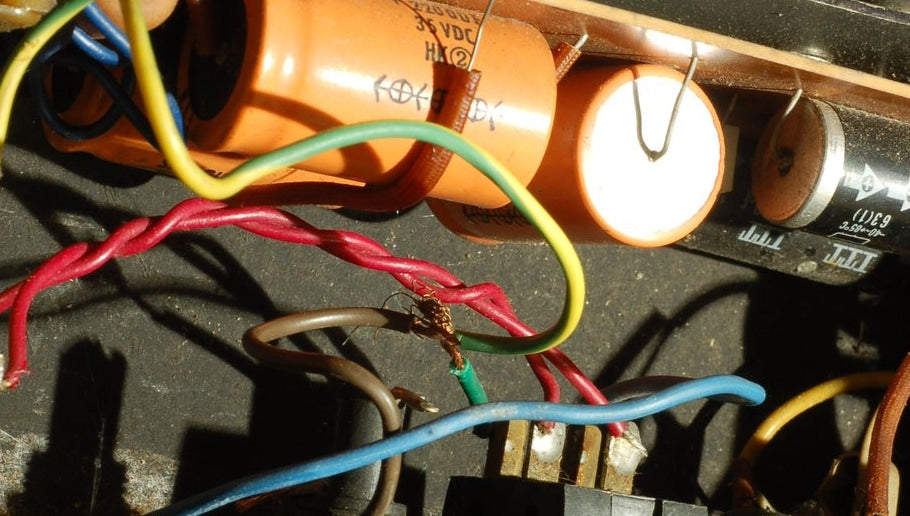
How Not To Fix Things (Especially Things That Turn)
There are few things more frustrating than having trusted an expert to fix something, only to have it returned more broken than it was to begin with! The wrong choice of “expert” will often result in a small defect which would have been relatively simple and inexpensive to repair, escalating into major damage, requiring much more extensive and expensive measures to put right.
This situation can be encountered with all manner of things, from audio equipment to household appliances, from cars to industrial machinery, from an alarm clock to a highway bridge! While some sectors are strictly regulated due to their critical nature, audio is usually regarded as a low-risk field, since nobody will die if the turntable has speed instability or if the amplifier is distorting.
Throughout my life, I have seen a lot of bad repair jobs, often in critical applications. As an example, a few years ago, I took our car to the garage to have some simple routine maintenance done on the brakes, by a mechanic who had proven knowledgeable and reliable – prior to the 2008 economic crisis. I drove the 40-mile trip back home safely, but while parking on my driveway, the brake pedal went all the way to the floor. Goodbye brakes!
Upon inspection, I saw that the mechanic had incorrectly (and outright stupidly) routed a brand new flexible brake hose around the suspension in a way that it would get squeezed between the car frame and a suspension member on each bump, pothole, etc. Luckily, it only broke on my driveway and there had been no emergency braking required on the way home.
As an engineer, formerly also having worked professionally with motor vehicles but doing much more complicated work nowadays, I do not find this difficult to fix on my own, properly and safely. However, as the day only has 24 hours, I cannot work full-time in the audio industry, fix my own car, build my own house, do my own plumbing, do my own electrical work, be my own gardener, cook healthy meals for the family, homeschool the children, manage my retirement investments, be my own accountant, fix the washing machine, fix the kettle, fix the camera, grow my own food, be my own doctor, and be proficient in all of these at the same time!
Inevitably, we all need others we can trust with doing their job properly, so we can focus on ours. Sadly, stories of bad plumbing, dangerous car repairs, and even fake doctors who never actually studied medicine are all around us.
Finding myself stranded with no brakes, 40 miles from the garage, with no intention of actually ever going back to the same mechanic as all trust was now lost, and needing to find a solution without wasting further time on what had started as a very simple issue, I lifted the car up on sturdy axle stands (I still had them around) and fixed it myself (I even had a new brake hose on the parts shelf), taking time away from what I should have been doing, if the mechanic would have done his job properly. Since then, I have gone back to doing all the car maintenance myself, as I am afraid that it may take much longer if I try to trust someone else with it, ending up with me having to undo what was badly done and redo it properly. But I really do wish there would be someone I could genuinely trust, nearby. Of course, I have met good car mechanics in my life, but they are all too far away from where we are currently living.
One can only hope that those tasked with working on airliners, nuclear reactors and medical equipment are proving more reliable.
While most failed audio and musical instrument repairs I have come across are indeed not as life-threatening, a few weeks ago I came across the world’s worst repair job and the most dangerous attempted audio repair I have ever come across.
It could perhaps even be considered a murder attempt!
I guess many of you will have encountered hi-fi equipment that is not performing as it should, and still doesn’t even after a trip to the repair shop and half a month’s pay relieved from your wallet. It gets a bit worse with studio equipment, but it is especially bad when it comes to musical instruments. So, I received this call from a friend who had bought a “restored vintage synthesizer,” which he initially described as, “I think there might be something wrong with it.” When it arrived in my lab, it was obvious that it had been badly bodged by someone clearly not qualified to carry out this type of work.
 Never use a fuse of the wrong rating!
Never use a fuse of the wrong rating!The two-prong power socket that had been fitted was unsuitable for equipment requiring an electrical ground and the chassis had been badly butchered in the process. The fuse installed was a 3.15 amp fuse, instead of the 315 mA indicated! My friend then added the best part: “I got a bit of a shock when I touched it!”
WARNING: The following picture may cause severe discomfort to sensitive, technically minded individuals.
 Notice the three bare wire ends twisted together (to the right of the twisted-pair red wiring) with no soldering.
Notice the three bare wire ends twisted together (to the right of the twisted-pair red wiring) with no soldering.
Opening up the power supply, we found some bare wires loosely twisted together, not even soldered. The fuse had been entirely disconnected (the round black housing with no wiring connected to it)! In European electrical color-coding, brown is the live wire, blue is neutral and the green/yellow wire is ground.
So, not only was an incorrect two-prong socket fitted, but the chassis ground had been twisted together with the live wire, essentially hard-wiring the 230-volt AC line to all of the exposed metallic parts of the instrument, and with no fuse in the circuit! According to the electrical codes in most European countries, the electrical outlets in the wall can deliver 16 amps, 13 amps or 10 amps of current at 230 Volts AC. And the only thing limiting the current flow would be the resistance of the body of the keyboardist! To put this in perspective, any current exceeding 0.03 amps is already considered potentially lethal.
The frame of the instrument was wooden, insulating the exposed metallic chassis at the top from the building’s ground.
The problem would not become noticed until somebody touched the chassis, which could then very well be the last thing they ever get to touch.
In theory, the electrical codes usually also call for an RCD (Residual Current Device) to be fitted to all electrical installations, to protect against such incidents by limiting such fault currents to 30 mA. So, why did the RCD not trip at my friend’s band’s practice space when he felt the shock?
Was he just lucky and the current just happened to be less than 30 mA because he simply did not make good enough contact with the chassis? Or was the RCD inoperative (or even entirely missing)? Perhaps another job badly done?
If the simple task of connecting three (already color-coded) wires properly is proving challenging in today’s times, then what is there to say of the challenges of maintaining a car’s braking system, the control rod system of a nuclear reactor, or the turbines of a passenger aircraft?
Considering that the dimensional tolerances and adjustment accuracy required for turntables, disk recording lathes and tape machines are at least an order of magnitude tighter than anything found in an automotive engine, it becomes clear that high-quality audio equipment, especially equipment with moving parts, must never be trusted to just anyone pretending to be a service engineer. It is all too easy and cheap to buy a soldering iron and pose as a “qualified audio tech.” But it really takes a lot more than that to be able to properly work on audio equipment.
Don’t be tempted by low prices for repair or calibration work. It takes a substantial investment in education and in quality tools to be able to do this kind of job properly, which will have to be reflected in the cost of the work. If the original manufacturer is still in business, this is the best starting point for getting an audio component repaired. For vintage audio equipment, there are very few people left in the world who can really claim to be adequately qualified. Seek them out and be prepared to pay them accordingly.
Supply tends to be regulated by demand. When more and more people demand cheaper and cheaper products, or cheaper repairs, more and more underqualified people will rush to “electrify” you, eager to cover the demand. At the same time, properly-qualified people may not be able to wait it out until everyone is done trying out if the services they provide can be had cheaper, so quality work and “a job well done” are increasingly at risk of becoming extinct.
As more and more people join the low-cost-everything sector, because of being paid less wages, they won’t be able to spend as much themselves. Eventually, there will be no market left for anything of decent quality, because nobody will be able to afford it, since everyone will be busy offering some sort of lower-cost product/service to attract a market share in an ever more price-conscious world. Who would be motivated to seek higher qualifications when they themselves have been rendered unmarketable?
This is exactly how American vacuum tube manufacturing collapsed, when cheaper but much lower-quality products flooded the market!
It doesn’t take much for things to escalate to the point where playing keyboards would be considered a high-risk activity! I keep on being reminded of the wise words of Peter Copeland, in his book, The Manual of Analogue Sound Restoration Techniques, about “the cost of everything and the value of nothing.”
It is up to all of us to keep the remaining highly skilled technicians, mechanics and engineers in business and see their skills passed on to the next generation.
(Note: “The Manual of Analogue Sound Restoration Techniques” is available for download from the British Library.)
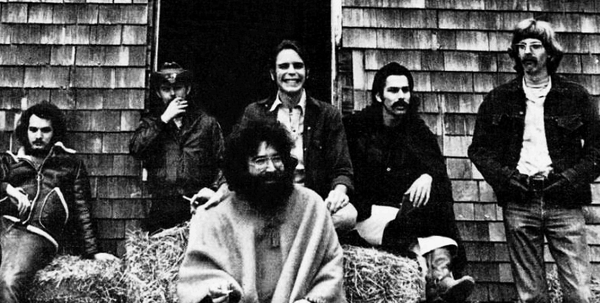
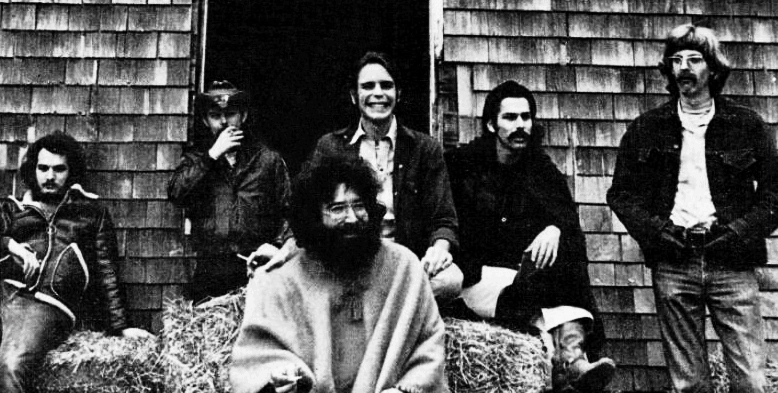
Me and the Dead: The Rocky Road To Unlimited Devotion
My first book, Twisted Business will be published in the first quarter of 2021 through RosettaBooks. It is a business book/memoir.
In it I go into detail about my life and the following story, while not an excerpt, was written just for my Copper readers to give you an insight into my musical journey…enjoy this exclusive look into my musical evolution.
Hey Jay Jay, Why do you make fun of the Grateful Dead?
Really…what’s up with that?
OK…it’s time to ’fess up to my comic routine, which goes like this:
I saw the Grateful Dead 27 times between 1969 and 1972. 26 times were on acid and I saw God each time. On the 27th time, I went straight and they were the worst band I ever heard in my life and I never saw them again!
If you’ve ever watched the Twisted Sister documentary We Are Twisted F***king Sister, I tell this above referenced story.
Shortly after the TS documentary came out, I got an e-mail from a guy named Justin Kreutzmann. He wrote to tell me that he had just seen the doc, loved it (he watched it five times!) and he thought my comments about the Grateful Dead were hilarious. Hmmm, I thought. The name Kreutzmann was strangely familiar. Could it be? Yes.Justin was the son of the Dead’s drummer Bill Kreutzmann. Justin is also a documentary filmmaker.
Justin got the humor. Many Dead junkies, however, don’t and get really offended at my comments. The Dead, Dylan, Springsteen…some of their fans have no sense of humor when it comes to this stuff.
Me? I could care less what anyone thinks of my band or whether or not they like what I like. I love the Beatles (as do some other folks) but when someone says to me that they think the Beatles suck, I just yawn…like, “who really cares.” The fact that I don’t get on a soapbox to proclaim the Beatles are the greatest band that ever existed, and defend them, also bothers some of my Beatles fanatic friends. That’s just plain nuts, in my opinion.
So, getting back to the Dead, allow me to finally describe my Dead conversion from “world’s biggest fan” to “If I never hear them again, it will be too soon.”
Sometime in the winter of 1967, I got an issue of Ramparts magazine. Ramparts was a counterculture mag and was at the forefront of the new super-literate, hyper-intellectual remaking of the new breed of journalistic criticism that also came to be represented by the music magazine Crawdaddy. Those writers were all college dropouts in love with rock music and hell-bent on describing its importance with intense prose and culturally rich but super-pretentious stories like “The Stones, the Beatles and Spyder Turner’s Raunch Epistemology.”
I was 15 and had no freaking idea what the hell that one meant!
Anyway, in 1967 Ramparts had done a story on the new San Francisco hippie music scene.
They covered the Grateful Dead, Jefferson Airplane, Country Joe and the Fish, Quicksilver Messenger Service, Big Brother and the Holding Company and Moby Grape. They described the Be-Ins and the legendary five-hour concerts in Golden Gate Park and the Winterland Ballroom, all within the background of free-flowing LSD supplied by Augustus Owsley Stanley III.
Here I was, in my bedroom in NYC, age 15 and fantasizing what it would be like to see these new bands. Free-form FM radio was just starting but this new music hadn’t hit yet but still, I had to hear these bands, so I went to Sam Goody’s record store on 50th Street off Broadway and found the Grateful Dead’s self-titled debut album.

I went home and played it incessantly.
Of all the above mentioned groups, the Dead were, at this stage, the least commercial-sounding and, with the crazy jam of “Viola Lee Blues” closing out their debut and me newly stoned from my discovery of weed, I felt that I was onto something that was really cool and very “inside.”
I grew my hair out to look like James Gurley from Big Brother and the Holding Company and I went full hippie.

In short order the Dead released Anthem of the Sun in 1968, and then Aoxomoxoa in 1969.
They finally came to the Fillmore East in 1969 and opened for Janis Joplin. Finally, I would get to see my heroes. There was a problem, however. They didn’t play five hours. They played about 45 minutes because they were the opening band. In fact, my memory of it, confirmed by Bob Weir when I met him a couple of years ago, is that they came out on stage, tuned up for 20 minutes, played one song and said goodnight.
It also happened a second time a couple of months later when they opened for Country Joe and the Fish. Same story. Same result but this time Country Joe announced to the crowd that he was going to flip the order the following night and let the Dead close so that New York could finally hear the Dead the way they were meant to be heard.
That next night was nirvana for me. As I remember it, as far as I can because I was pretty wrecked on psychedelics at the time, was that, when they ended and the doors opened up, the morning light shone in.
Whoa….
I became a Dead addict. Every time they came into New York or the surrounding area over the next three years, I was there. I totally “got” them. I absorbed every nuance of every song. I played all the albums seemingly endlessly. Workingman’s Dead, American Beauty, Grateful Dead (the “Skull and Roses” album), Jerry Garcia’s solo album as well as Bob Weir’s Ace. I couldn’t get enough. We, meaning the Dead and my drug-laden brain stem, were connected. Totally.
When it came to live shows, the Dead shows were all framed around LSD. The only other band that I connected the acid experience with was Pink Floyd, especially their debut album The Piper At The Gates of Dawn. Pink Floyd, however, didn’t tour much in those days, although I once had tickets to see them with Syd Barrett but Syd lost his mind and left the band about a month before the scheduled Fillmore show. It was cancelled and when they did return, they came back with then-new guitarist David Gilmour.
 The Grateful Dead, 1970. Courtesy of Wikimedia Commons.
The Grateful Dead, 1970. Courtesy of Wikimedia Commons.
The Dead and LSD were intrinsically connected. The hippie in me was also enmeshed in this scene. It was all tied together – and this is where the break with the Dead had to happen.
In the Spring of 1972 a series of events took place in which I had to decide where my life was going. The drug scene in New York City, especially at the fountain in Central Park, had succumbed to heroin in the circles I traveled in and everyone around me was becoming a junkie. I had overdosed on heroin the summer before and my best friend Victor and his current girlfriend at the time were stashing hypodermic needles at my apartment. I woke up the morning of Easter Sunday 1972 and decided that, in order to save myself, I was going to stop all drug use the following Monday.
I did.
Except for some occasional pot smoking, my drug taking and dealing days were over. I also knew that I had to leave Manhattan for a while to avoid the peer pressure of falling back into the scene.
I joined a bar band in New Jersey and spent the summer living on a farm in Wilkes-Barre, Pennsylvania rehearing with a band that only lasted one show on the following Labor Day weekend.
For reasons that can only be described at cosmic, I decided to subscribe to a Crawdaddy-style rock magazine called Fusion. The magazine offered three free albums with a subscription. David Bowie’s The Rise and Fall of Ziggy Stardust and the Spiders from Mars, Mott The Hoople’s All The Young Dudes and Lou Reed’s Transformer.
The magazine came with Bowie on the cover with a full color story about David Bowie and his Ziggy Stardust alter ego, and the three albums that came with the magazine all seemed to be connected to Bowie. Not only was Ziggy mindblowing but Bowie had produced the Mott album and also wrote the title song, and both Bowie and Mick Ronson, his guitar player, produced the Lou Reed album. Not since the Dead, and before that, the Beatles, had some artist or band had such an enveloping effect on me.

The look of the Spiders from Mars was not “hippie,” it was androgeny. It was dark and foreboding. It was dangerous and sexy as hell. I wanted to be a part of that, not a Deadhead anymore but a Bowie devotee. I couldn’t see how the two musical lifestyles could coexist within me.
I had to prove to myself that I had moved on, so I agreed to go with some friends to see the Dead one more time at Roosevelt Stadium in Jersey City in October of 1972. I was still looking like a hippie but I wanted to cut my hair, dye it blond and look like Bowie’s guitar player Mick Ronson, my new guitar god.
I went to see the Dead. Straight. Not high on anything for the first time in the many times I’d seen them.
I said to myself: where are the songs? Where is a melody? Where is a great guitar tone? Where is their image?
In short, I had moved on into another world and I got up during intermission and walked out of the stadium, convinced that the Dead were yesterday’s news. They were over and done in my eyes.
I was convinced that the Dead’s best days were behind them, I was there, I rode the cosmic bus with them, but that was all she wrote!
In order to change I had to totally transform into a glitter god and never look back. The Dead became everything I had been and everything I had to leave.
Goodbye Grateful Dead, Hello Twisted Sister!

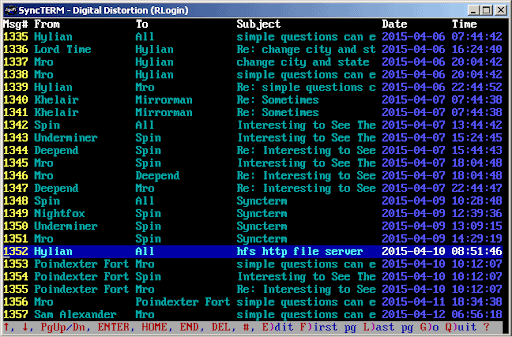
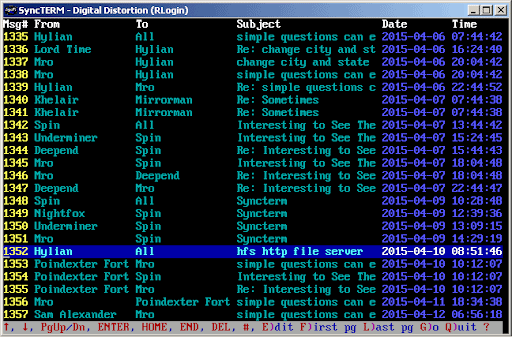
Tales of an Audio Forum Administrator, Part Four
The final installment in Rudy’s behind-the-scenes series on what it’s like to be an audio forum administrator…
“Why did you delete my post?”
“Insulted me in this post.”
“You are stifling my free speech!”
“OP is thread-crapping.”
“The moderators deleted my thread.”
“Your forum is racist!”
“Spam alert!”
“This person is dragging political content into this discussion.”
These may not be verbatim quotes, but they do reflect the typical complaints the moderation staff sees either in their report queue or through a private message. Like most modern forums, ours have a report link under each post for reporting content that triggered a member enough to want to point it out to the staff. While some of the reports are not really a problem, the rest usually involve a complaint about some sort of content that goes against our published forum policies.
Yes, the policies, also referred to as rules. All forums have them. The better forums go beyond a generic set of rules and point out specific situations or behaviors that are not allowed. They are not only a set of expectations for members of the forum, they also serve as a guideline for the staff to assist in determining if problem content requires attention or not, and how much of a correction (punishment) needs to be dealt.
The staff has various means of correcting its members. The simplest might be an admonition within a thread to all participants that the discussion has gone off the rails: “We’ve just now cleaned up several posts of bickering. Let’s try to stay on topic here.” Other times, the moderators will issue a warning through a forum’s warning system, while others might involve a private message to the offender(s). The most severe result is a ban from a thread, a “vacation” from the forum in the form of a temporary suspension or the most final of all punishments, a permanent ban from the forum. Anyone who has moderated, especially in large forums, has seen a great many behaviors over the years.
Overview of Forum Policies
When adopting a set of rules for a forum, the staff attempts to keep the list simple, but that never happens in practice. We could easily try to get along with a single sentence to cover everything: respect others’ opinions, do not attack other members, avoid politics/religion/etc., keep discussions and content family-friendly, stay on topic, and address issues with staff privately. Yet the most mischievous of members will find any way possible to skirt the rules to say their piece by sneaking some of their comments in under the radar, or blatantly posting something in a pointed attack. It’s because of this reason that forums end up with a long list of policies. The best forum policy list always has the final disclaimer: “Anything else the staff deems unacceptable.”
Despite that, as a famous film once said, “Some men you just can’t reach.” And so it goes with running a forum. Some are habitual rule breakers. After a while, you get to know which members might drag politics or race into a discussion. Others you know will disrupt a thread with opposing opinions. A few will try to self-promote their own sites, creations or products when they aren’t watched too closely. There are plenty, also, who know how to stay within the rules just enough to fly under the staff radar and, when caught, their punishment isn’t too severe.
. 
On the other hand, some members do not communicate well, and may come off as brusque or highly opinionated – they aren’t exactly breaking the rules, but they may not be the most pleasant to engage with on a forum. Some might also speak a different primary language than the forum’s membership, making communication a bit awkward. Also keep in mind that everyone has different situations going on in their lives, and everyone can have a bad day.
Make Our Job Easier!
With all of that in mind, remember two things to make a forum a more pleasant visit for everyone involved: remember that there is a real person on the other end, and only say something on a forum that you would say to them in person, face to face.
Wishful thinking, I know.
There are topics and behaviors that will come up in any discussion. Here is a sampling of what moderators deal with on a frequent basis, and what forum visitors can do to help guide discussions in the right direction.
“Let me guess who you voted for.” “Spoken like a typical ____ supporter!” Politics. One of our most dreaded topics. Historically, any discussion that even remotely involves politics will turn into a dumpster fire. Onto which someone has poured ten gallons of gasoline. Unless the discussion board is specifically about politics, just avoid the topic entirely. Remember that many people visit their enthusiast forums to get away from the daily onslaught of the media.
Are there other taboos? Yes, indeed. Avoid bringing religion into a discussion – you’re bound to offend someone. Posts discussing race, racism or xenophobia, LGBTQ issues, and other lifestyle choices that many will not agree with are also not a good idea as they are highly polarizing for many.
Remember to keep your contributions family- and workplace-friendly, as many forums frown on nudity or suggestive photos, as well as varying levels of profanity and sexual content. Forums with this policy are often not doing it to be prudes. Keep in mind this interesting factoid from years of observing server logs: our forums have historically had the most traffic during working hours. Accessing potentially offensive content could not only land you in trouble with your employer, but the forum itself could be flagged as having offensive content by services that can block traffic on a network based on content. (OpenDNS is one such service that offers optional filtering, in addition to DNS services.)
For lesser taboos, consult the forum’s policies. Some are more friendly to recreational substances than others; some may limit discussion to alcohol (many enjoy a beer thread, for instance), where others may allow discussions of cannabis. Most, however, frown on anything illegal like describing how to shoot up heroin, or blueprints to build your own home meth lab.
Legalities stem to other areas also. If you are in a music, audio, video or book forum, posting links about how to download something copyrighted for free will get your post removed in no time. “Hey, I found a link to download free Hi-Res music from this blog!” Umm, no. “I got the latest TV episode of Star Trek: Picard from torrents; I’m not paying CBS!” Don’t go there either. In addition to being illegal, this can land the site owner, staff and the person making the post in a lot of hot water. Links to buy illegal merchandise or illegally hack software are also not welcome.
Keep in mind the forum’s ownership when participating, as they often have rules unique to their situation. Anything deemed industry sensitive may be removed at the staff’s discretion, for example.
In addition to taboo topics, there is a long list of behaviors from the small number of problem members in a forum who will get worked up enough to disrupt a discussion. Here’s a handful of the most common of these. Avoid them, and you’re golden!
Thread crapping: Using an audiophile forum as an example, thread crapping is entering a discussion about vinyl to say that CDs are superior. Commenting that power cords are snake oil in a thread discussing power cords is another thread crap. If the topic were a question or debate asking for both sides, then it is acceptable. Otherwise, derailing a conversation and injecting negativity is frowned upon.
Calling out the staff: If you don’t approve of how your content was handled (perhaps we deleted your post), contact the staff directly. Don’t use the forum to air your grievances. Likewise, if you disagree with our rules, you can complain to the staff about them, but be aware that it’s probably best you avoid our forum entirely. We occasionally get a backlash, saying we don’t allow members freedom of speech; however, since the forum is a privately owned and operated enterprise, it is subject to its own policies, not those of the government (where freedom of speech applies).
Attacking fellow forum members: attacking another person in the forum is another that needs no explanation. Baiting, insulting, name-calling, etc. are all attacks we can do without.
Attacking people outside the forum: while most understand that attacking fellow forum members is not allowed, some still feel a forum is a safe haven to attack people outside the forum without punishment. Engineers, salesmen, anyone in the entertainment industry, members or staff of other forums, the local Maytag repairman…you get the idea. Members may feel the need to warn others about certain individuals, but that is skating a thin line. Our forum is not a place to air grudges about others you’ve encountered in life.
We are not customer support: as an extension to the rule above, using a thread in a forum to tell us all about your problems with a product and the company that sold it to you is not appropriate. Not only do some of these companies frown on it (and will request it be removed), the staff doesn’t want the forum to be known as a place that visitors ca turn to for airing problems with third parties.
Complaining about ads: If the ads are intrusive and interfering with how a forum functions, by all means point it out to the staff. But complaining about ads and monetization in general won’t ingratiate you to the staff and the forum’s owner(s). Most forums exist on that income to pay for server fees, licensing and domain fees and renewals, developer fees, etc. If the ads are not all that intrusive, consider whitelisting the site in your ad blocker to help keep the lights on. Purchasing through links on the site may be monetized also – take advantage of those as well.
There are more issues on a forum, as you can imagine. Overall, respect your fellow forum members and you’ll get the most enjoyment out of any forum you choose to visit. If you feel harassed, threatened or like you’re being attacked, don’t take matters into your own hands or engage with the troublemaker – report the offending content.
To wrap up this series on forum moderation and administration, I would like to thank you all for reading. I hope a behind-the-scenes look at running a busy discussion board has given you some insight as to what the staff sees daily, and how we deal with it. The internet would be a boring diversion for us if we did not have our niche forums to visit and interact with fellow enthusiasts. May your journey on the Internet be a safe and enjoyable experience!
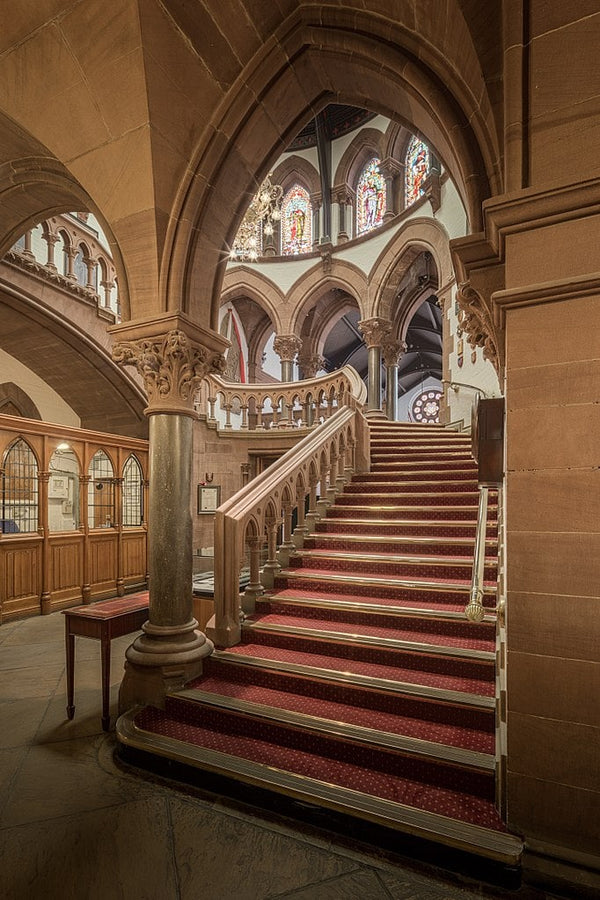
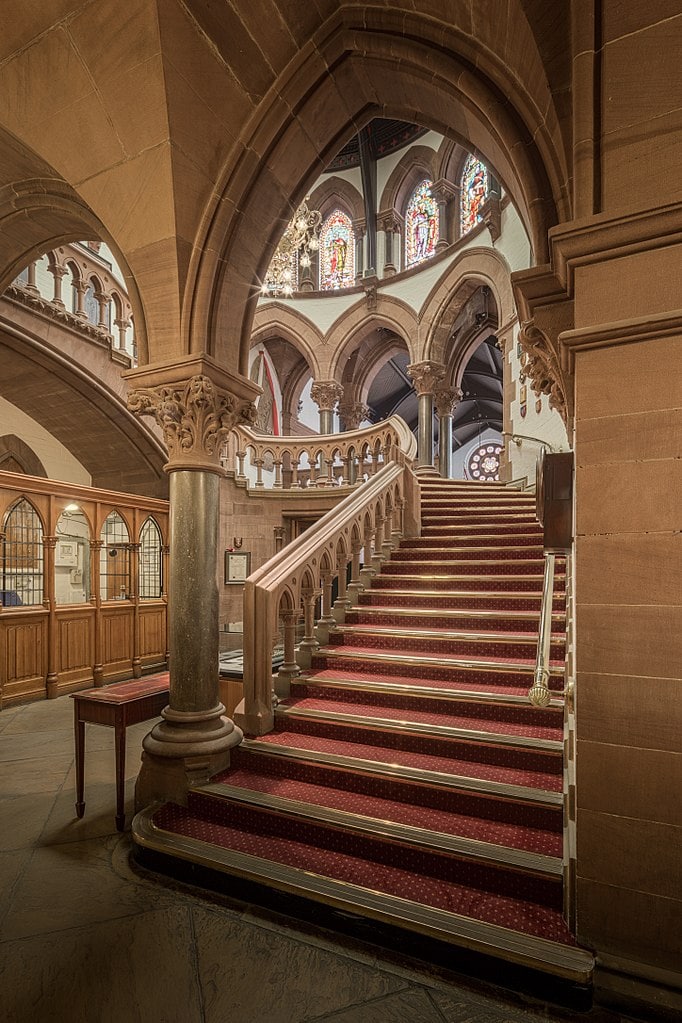
Confessions of a Setup Man, Part Six: Sinister Stairways
What Goes Up, Must Come Down
When I worked at The Absolute Sound as Harry Pearson’s setup man he had a strict rule: no shoes could be worn in his house. I understood – aside from being a sign of respect, it helped keep those thick red carpets in the first floor listening rooms and the nice wood floors on the upper stories clean.
One disadvantage, of course, was that when you accidentally dropped a heavy box or piece of gear on your foot – ouch! Somehow I never broke any bones but there were days when I limped to work. (Towards the later part of my TAS tenure, I limped in mentally as well, but that’s another story.)
So, when entering Harry’s Sea Cliff house, you had two options – socks or barefoot. I would always wear socks and in fact in the seven years I worked at TAS I never was barefoot. Never. Because my feet were ugly.
I’ve had psoriasis since I was 14. As a result, my toenails looked like the “before” pictures in those TV commercials advertising medications for clear nails. My feet were also red and cracked. I would do anything to hide them.
Ewww, why am I telling you this? Read on…
One of the best parts about working at The Absolute Sound was when we’d get in a fantastic piece of equipment. Around 1991 a pair of Atma-Sphere MA-1 monoblocks arrived. These were somewhat unique in that they were an OTL – output transformerless – design. OTL amps had had their adherents, perhaps most notably the late Harvey “Gizmo” Rosenberg of New York Audio Labs and an acolyte of OTL amp pioneer Julius Futterman. (Rosenberg was quite a character – he would show up at shows wearing kilts and headgear decorated with vacuum tubes. I recommend reading his long out of print book, The Search for Musical Ecstasy Book One: In the Home, if you can find a copy. It’s…different.)
 Atma-Sphere MA-1 MK 3.3 amplifiers. The original MA-1 looked different, but you get the idea.
Atma-Sphere MA-1 MK 3.3 amplifiers. The original MA-1 looked different, but you get the idea.In any case, OTL amps had their devotees, who insisted that this type of amp sounded better because of the elimination of the sonically-degrading output transformer. (Other OTL manufacturers include Linear Tube Audio, Einstein and more.) On the other hand, OTL amplifiers had a reputation for unreliability.
The Atma-Sphere MA-1 amps, designed by Ralph Karsten, were marvelous though. Class A operation, direct-coupled OTL output stage, 14 big 6AS7G output tubes per monoblock, 140 watts into 8 ohms. Sweet, detailed, revealing of every nuance in the music, dynamic, just wonderful all around. And totally dependable (auto-biasing, yay!). They had a tonal purity about them that sounded natural and “right.” (They also weren’t crazily priced for a true high-end amp; $5,800 per pair in 1991.) I could have lived happily ever after with these.
At one point, Harry decided he wanted to take the MA-1s out of the big system I’d initially installed them in and try them in a secondary listening system. I dutifully schlepped the amps up the roughly 20 flights of polished wood stairs.
After a couple of months, he decided he wanted to hear them in the big system again. “Zoid! Get those MA-1s and hook them up to the IRS!” (Zoid was a nickname Harry had given me; the IRS was the Infinity Reference System V speaker system.)
OK…I unhooked one of the big, 36-pound amps, carried it to the foot of the stairs, stepped down the first step…and slipped!
Reminder, I was wearing socks. White slippery socks on polished slippery wood.
I fell on my back. A corner of the amp slammed into the wall, hard enough to gouge the wall. I kept sliding and bouncing down the stairs. A couple of the big power tubes smashed into the wall and shattered. Bounce, bounce, crash, ow, ow, agghhhh! I was doing a bobsled run and I was the bobsled on a course full of sharp bumps. My back and left arm were pounded by the steps. Hard!
Finally I landed.
Holy crap. Let me try to get up. OK, I can move. My back and left elbow are killing me, but I can move.
The amp!
Aside from the smashed tubes it seemed to be OK. In fact, the corner that had gouged the wall looked fine except for a little bit of paint coming off. There was a lot of broken glass, but none of it in me.
Harry checked to see if I was OK. I seemed to be other than needed a Band-Aid for my elbow. But I just wrecked Ralph Karsten’s amp!
Or so I thought, After somewhat composing myself I cleaned up the glass, called Ralph and explained the situation. He asked if I could take the amp apart and look at it. I did, and aside from the broken tubes everything actually looked fine. Ralph said he’d send me some replacement tubes. A couple of days later they arrived, I installed them and, hoping an Eniwetok Atoll explosion wouldn’t erupt, turned the amp on.
It was fine.
Postscript 1: I recently contacted Ralph Karsten about this and he noted, “That was one of our early MA-1 amps. We built that amp to be pretty durable. We had sorted out how to make OTLs reliable…and to underline that we built the amp to also be physically tough. So the corners on that chassis were welded and ground. It was pretty hard to break it! By the way, that amp got updated a few years ago and is still in the field running right now.”
Postscript 2: My feet look great these days, thanks to a good dermatologist and prescription drugs.
Sufferin’ Stepectomy!
After months of back and forth negotiations with company president John Dunlavy (sadly deceased), Sea Cliff was going to get a pair of the mighty Duntech Sovereign loudspeakers! (It was a couple of years or so after they were introduced.) These loudspeakers were more than 6 feet tall, almost three feet deep, seven time-aligned drivers, 275 pounds each. I was told I’d get a call when they were going to be shipped.
 Duntech Sovereign loudspeakers.
Duntech Sovereign loudspeakers.Well, I got a call all right – from the trucking company a few days later, completely unexpected, telling me that they had just arrived in Harry’s driveway. I rushed to the house from the office. By the time I got there the delivery guys had dropped off the speakers, in the middle of the driveway. I was about to ask if they could help me get the two huge crates into the house when I noticed…
The house was missing the porch.
Whaaaa?
I mean literally. The wooden porch, which extended all around the house and was about three feet high, was gone. Including the steps to the front and back doors. Removed by workmen who had arrived that morning and taken it down.
No one had told me this repair was going to be done.
So there I am, with two gargantuan wooden crates weighing more than 300 pounds each – and a roughly three-foot-high gap between the ground and the door to the listening room.
I called to one of the delivery guys. “Can you help me get these crates in the house?” “Oh no, we’re only authorized to deliver to the front door.” No amount of pleading could convince them to bring the crates inside. And the weather forecast wasn’t good so the crates could not stay out overnight.
I’m standing there looking at two immense crates and a chasm between the ground and the front door. What was I supposed to do? Wishing that I had gone into another line of work wasn’t helping.
I called a friend and he was able to come by, but we needed at least four more people. Harry wasn’t around.
I turned to my friend and said, “I’ll go into town and see if I can get some people to help.” I looked in my wallet and had about $40 with which to pay them. Great. I walked down Sea Cliff Ave. and went to Arata’s, the deli where we were regular customers, explained the situation and asked them if anyone there could help. “I can pay you $10 each.” Mercifully, or maybe they just took pity on me, I got a couple of guys and two more random men who happened to be on the street. We paraded back to Harry’s house.
We did a test lift of one of the speakers and it was extremely difficult – but do-able.
Except that the stairs to the house were gone!
So, instead of being able to walk the crates up the stairs we had the immensely more difficult task of lifting each crate using a combination of hand truck (thank goodness one was there) and muscle, then bringing the crate to the front of the house, lifting the end and balancing it on the lip of the doorway. Then push the other end of the crate up, and maneuver the $*&@%! thing into the house, all the while trying not to rub the crate on the floor and gouge the crap out of it.
Why didn’t we take the speakers out of the crates first and make them easier to carry? I didn’t want to damage them. Oh yeah, Harry’s driveway was covered with pebbles, not exactly ideal footing. If we would have slipped and dropped the speakers, well, that was not a phone call I would have wanted to make to John Dunlavy.
Somehow we got the crates in. At least the front doors were big double doors, a small mercy. But it was agony. We all had to strain ourselves to the limit and go through backbreaking contortions to get those things up to the door without dropping them. At many points I thought we surely would drop the crates. I was worried I’d injure my hands. It’s a miracle no one got splinters. Finally we got the crates in and the speakers out. Those other guys couldn’t get out of there fast enough.
Was it worth the effort? The speakers were wonderful. Talk about dynamics and scale! The Sovereigns effortlessly reproduced the spread of the orchestra with a wide and deep soundstage and a majestic “you are there” feeling. Their tonal balance in Harry’s room was exactly right, and the speakers delivered deep, articulate bass. The Sovereigns could also “do” intimate; female vocals, Gordon Lightfoot, Leonard Cohen. But. Although I recall Harry giving them a good review, he never really warmed up to the Duntech Sovereigns the way he did with the IRS Vs. I liked them both equally.
In fact, I’d love to hear the Sovereigns again. Only next time someone else can set them up. I had hernia surgery in 1999.
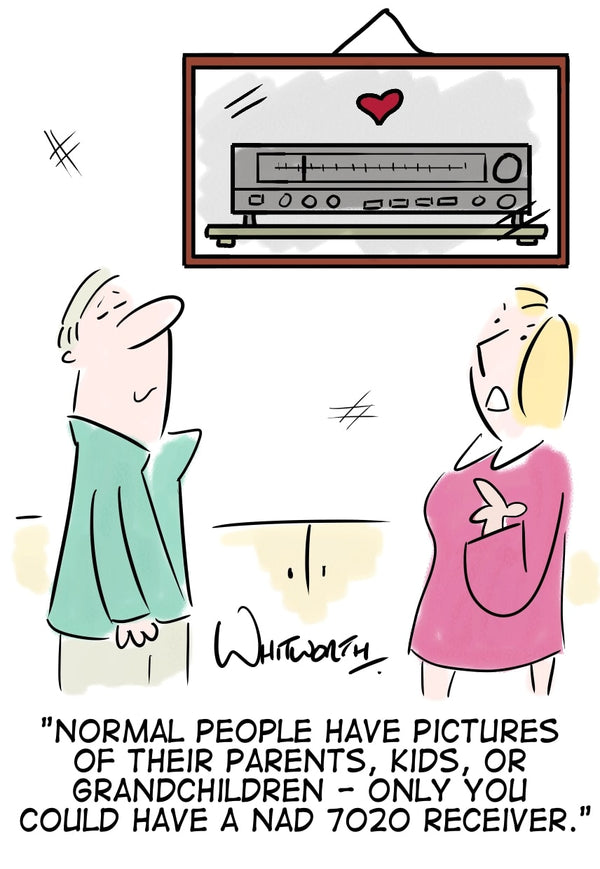
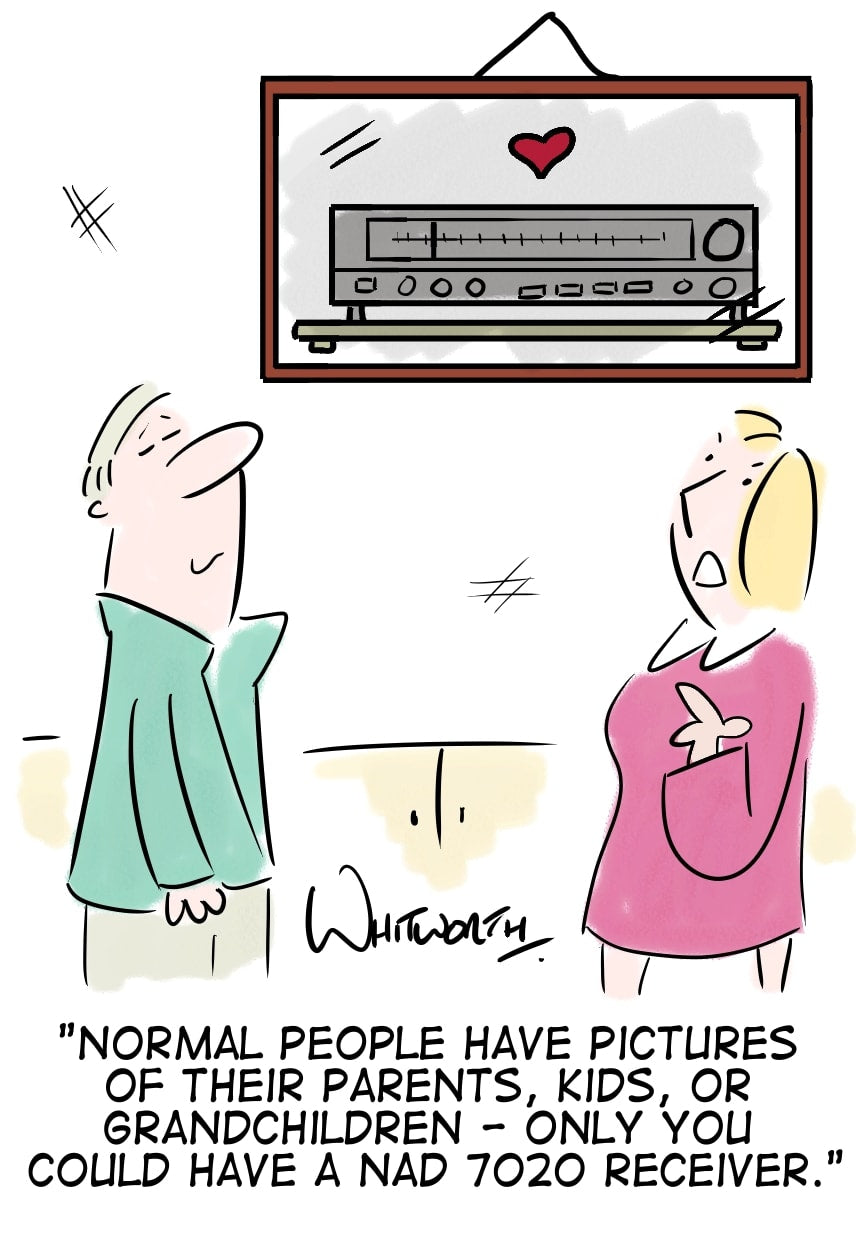


Women Composers of Early Music
If you ask people to name a famous classical music composer they’ll probably say Bach, Beethoven, Brahms or Mozart – all men. If you ask people to name a famous woman composer they might say Clara Schumann or Fanny Mendelssohn. But were there any accomplished women composers prior to the 19th century? Who were the talented women composers during the medieval, Renaissance and Baroque periods? And what prevented them from becoming better known today?
The contributions of women composers date back to at least the ninth century. In an article published by Smithsonian magazine, Anna Beer points out:
“…there are many painfully underappreciated female composers who were undoubtedly great. These forgotten women achieved artistic greatness despite the fact that for centuries the idea of genius has remained a male preserve…
“[They succeeded] despite working in cultures which systematically denied almost all women access to advanced education in composition… despite having their art reduced to simplistic formulas about male and female music…and despite subscribing to their society’s beliefs as to what they…could (and could not) compose as a woman….
“Yes, women wrote music, they wrote it well, and they wrote it against the odds.”[1]
Fortunately historians have rediscovered some of the women composers who achieved fame and artistic greatness regardless of the restrictions placed on them. Several of the most notable ones are described below.
The Earliest Composers
Kassia [Kassiani] (c. 810 – c. 867), a Byzantine Greek poet and abbess, is the earliest female composer whose music has survived and whose scores can be interpreted by modern scholars. Sometimes referred to as the first female composer, Kassia’s melodies feature settings that closely reflect the rhythms and structures of the text, and musical motifs that are often used to mirror the words. Over 50 liturgical works have been attributed to Kassia although recent research has shown about half may not have been written by her.
 Kassia. Courtesy of Wikimedia Commons.
Kassia. Courtesy of Wikimedia Commons.
Kassia was famous in Byzantium for her popular hymn known as “The Hymn of Kassiana.” The music is slow, sorrowful and plaintive, is usually sung by an accompanied soloist but is also performed by choirs singing in unison underpinned by a Byzantine vocal bass drone.
Hildegard von Bingen (1098 – 1179) was a well-known German saint, composer, writer and visionary. Her theology and mysticism made her one of the most influential women in Europe and she is the earliest composer we have any clear biographical details about.
At the age of seven Hildegard’s parents sent her to be enrolled as a novice in the convent of Disibodenberg in the Rhinelands:
“For upper-class women, the convent filled several basic needs. It provided an alternative to marriage by receiving girls whose families were unable to find them husbands. It provided an outlet for nonconformists, women who did not wish to marry because they felt a religious vocation, because marriage was repugnant, or because they saw in the convent a mode of life in which they could perform and perhaps distinguish themselves. The nunnery was a refuge of female intellectuals.”[2]
 Hildegard von Bingen. Courtesy of Wikimedia Commons.
Hildegard von Bingen. Courtesy of Wikimedia Commons.
Hildegard lived at Disibodenberg for about 40 years until she left in 1150 to found the Rupertsberg monastery near Bingen so her nuns could be more independent from the monks. She refused to be defined by the patriarchal hierarchy of the church and, although she followed its strictures, pushed the boundaries established for women.
In addition to writing songs for the nuns to sing at their devotions she wrote numerous poems, letters, books, works on biology and botany, and medicinal and devotional texts. She argued that if humans cared for nature, nature would do the same for them, and claimed the Divine was as female in spirit as male – elements that were both essential for wholeness. Despite being controversial Hildegard regularly corresponded with kings, queens, political leaders and many others, and became a recognized prophet known as “The Sibyl Of The Rhine.”
Hildegard was rediscovered in 1979 around the 800th anniversary of her death when Philip Pickett and the New London Consort gave what were possibly the first English performances of four of her songs. Until then it appears Hildegard’s music was only heard inside her own convent. Today there are several recordings of her music and she is considered by many as a New Age guru and early feminist.
The “Sibyl’s” compositions differed from other liturgical music because her melodies were freer, more wide-ranging and elaborate than those used by her contemporaries. She wrote the oldest surviving morality play, Ordo Virtutum, a drama about the struggle between 17 Virtues and the Devil over the destiny of a female soul. It features melodies for the human soul and Virtues but the Devil who, in later music periods, usually got the best melodies doesn’t get any of the best tunes here: He is reduced to having a speaking role.
Middle Ages
During the middle ages, in the world outside church walls, female troubadours (trobairitz) wrote secular music. The most common musical form used by the trobairitz was the canso, a song in stanza form on topics of courtly love. The songs of the trobairitz help us understand how their society influenced attitudes toward women for centuries to follow:
“Female troubadours…wrote lyrics that followed the courtly love tradition of the troubadours in that they involved themes of adulterous love, the elevation of the lady over the man who loves her, and the torturous nature of romantic love, itself….It’s important…to point out that the placement of women on a pedestal in the courtly love tradition did not do much to dispel the misogyny in society or in art, however. Some of the troubadour lyrics are viciously misogynistic.”[3]
Renaissance and Baroque Composers
Social roles throughout the Renaissance continued to center around the idea that women should perform domestic duties and live humble and pious lives. However, the 16th- century also brought about some changes: Young women like composer, lutenist and singer Maddalena [Mezari] Casulana (c. 1544 – c. 1590) were offered the opportunity to pursue academic studies. Using her education and talent Casulana chose to pursue a career in music, singing and teaching in salons and academies where women were more readily accepted.
Casulana is notable because she was the first female composer to publish an entire book of her music. Her Primo libro de madrigali a quattro voci (Venice, 1568) was dedicated to Isabella de’ Medici Orsini, the main musical subject of these madrigals. In her dedication Casulana expressed her admiration for de’ Medici while sharing thoughts on being a woman composer in a field dominated by men: “I know truly most excellent Lady, that these first fruits of mine…in addition to providing some evidence of my devotion to Your Excellency, also…show the world the futile error of men who believe themselves patrons of the high gifts of intellect, which according to them cannot also be held in the same way by women.”[4]
Sulpitia Lodovica Cesis (1577-1619) composed, taught and played the lute at St. Geminiano in Modena, a convent renowned for the high quality of its music. Cesis’ compositions differed from her contemporaries by including indications for instruments such as cornetts, trombones, violones, and archviolones.
Her only known work is Motetti spirituali, a collection of motets for 2 – 12 voices published in 1619. The 12-voice works are important because they differ from the usual 2 – 3 voice works that were popular in the 17th century. These motets were dedicated to a nun with a similar name, Anna Maria Cesis. Like in Casulana’s dedication, Sulpitia’s dedication referred to the problems women composers faced. Sulpitia wrote “…with the splendor and nobility of your name these few musical labors may be defended against the meanness of their detractors and also that they might occasionally be performed in the convents of nuns in praise of our common Lord.”[5]
One of the most famous and influential female composers during the Baroque period, Francesca Caccini (1587 – 1640) was able to sustain a full time professional career. Caccini, daughter of the Renaissance composer Giulio Caccini (an important Italian composer of the early Baroque era) sang and was proficient on the harp, harpsichord, lute, theorbo, and guitar. By the time she was 20 she was a musician at the Medici court where she continued to work throughout her career. By 1626 Caccini was the most prominent woman musician in Europe.

Caccini was responsible for composing La Liberazione di Ruggiero dall’isola d’Alcina, the first opera written by a woman. Premiered in Florence in 1625 the opera so inspired the King of Poland that he rushed back to his home country, created his own opera house, and asked Caccini to provide the first works for it.
In addition to composing hundreds of songs she spent time collaborating with other court musicians and performing in private and public. Caccini continued to write and teach later in life but the rest of Francesca’s activity remains a mystery: She left the Medici court in 1641 and was never heard from by the public again.
Chiara Margarita Cozzolani (1602 – c. 1676 or later) had an unusual amount of music published for a female composer during the 17th century. Similar to Sulpitia Cesis, Cozzolani spent her adult life within the walls of a convent famous for its music making (the monastery at St. Radegonda). In a report from Abbot Filippo Picinelli’s Ateneo dei letterati milanesi (1670), Picinelli found:
“The nuns of Santa Radegonda of Milan are gifted with such rare and exquisite talents in music that they are acknowledged to be the best singers of Italy…who fill hearts with wonder, and enrapture tongues in their praise. Among these sisters, Donna Chiara Margarita Cozzolani merits the highest praise….”[6]

Warren Stewart, artistic director of Magnificat Baroque Ensemble (a group that promotes and performs music by women composers) notes that “one of the reasons for the superiority of the music in convents in Milan in the relatively brief period in which Cozzolani was active as a composer can be traced to the devastating plagues of 1630 and 31 that ravaged the male musical institutions and all aspects of society in Milan and throughout northern Italy. By contrast all the nuns in Milan survived the plagues, most likely because they were effectively quarantined… As a result the experienced performers and teachers among the nuns survived to carry on the already well-established musical traditions.”
Cozzalini resisted Church restrictions: she provided guidance during the 1660s when the convent was attacked by Archbishop Alfonso Litta who wanted to limit the nuns’ musical practice and other “irregular” contact with the outside world. Much of her finely crafted music has been lost but enough remains to refer to her as one of the leading composers of mid-century Milan. She published four collections of music between 1640 and 1650, two of which survive complete. The final published volume contains a nativity piece for eight voices with parts for men, demonstrating the beginning of more inclusive spiritual and musical relationships.
Barbara Strozzi (1619 – 1677) was the adopted daughter and likely illegitimate child of renowned poet Giulio Strozzi. She was said to be the most prolific composer, woman or man, of printed secular vocal music in Venice during the 17th century. Most women composers of the time had to use a male pseudonym in order to get their creative works in print. Barbara put her own name on everything she wrote, making her one of the first female writers of secular music to publish in this way.

Her music is especially striking because of the care she took in creating an unusually close relationship between words and music. Most of the poetry was about love and modeled on the ornate Marinist style that valued wit, erotic imagery, sensuality, extravagant metaphors and fantastic word play.
Other important composers during the Baroque period include Isabella Leonarda who also composed a significant body of vocal music, and Élisabeth Jacquet de la Guerre, the first French composer of sonatas.
Isabella Leonarda (1620 – 1704) entered a convent at age 16 and remained there for the rest of her life. She was not well known as a singer or instrumentalist, but was one of the most prolific convent composers of the Baroque era. Her Sonate da chiesa, Op.16 published in 1693 was the first published instrumental sonata by a woman.

 Elisabeth-Claude Jacquet de La Guerre by François de Troy, who painted this sometime during the late 17th-early 18th century. Courtesy of Wikimedia Commons.
Elisabeth-Claude Jacquet de La Guerre by François de Troy, who painted this sometime during the late 17th-early 18th century. Courtesy of Wikimedia Commons.
Her first published work was the Premier livre de pièces de clavecin (1687), one of the few collections of harpsichord pieces printed in France during the 17th century. The work consists entirely of dance pieces grouped by key, with each group preceded by an “unmeasured prelude” that doesn’t adhere to a strict pulse and comes close to improvisation.
Throughout the 1690s she composed a ballet, had her opera Céphale et Procris – the first opera written by a French woman – premiered, and wrote a set of trio sonatas that are among the earliest French examples of the sonata. In 1707 a new set of harpsichord pieces, Pièces de clavecin qui peuvent se jouer sur le violin was published followed by six Sonates pour le violon et pour le clavecin. These works are early examples of the new genre of accompanied harpsichord works where the instrument has an obbligato role with the violin.
_________________
Most of the music written by early music women composers is missing, wasn’t published, or was only sung or played in a convent. Whether cloistered from the outside world or restricted by societal attitudes, enough music exists today for us to appreciate the importance of these composers and the beauty of their music.
For Further Exploration
CDs
Caccini, La liberazione di Ruggiero dall’isola di Alcina, ensembles Allabastrina and La Pifarescha, dir. Elena Sartori, GLOSSA (GCD 923902, 2016)
Caccini, O Viva Rosa, Shannon Mercer, ANALEKTA (AN 29966, 2010)
Cesis, Motetti spirituali 1619, Cappella Artemisia, TACTUS (TC 572801, 2009)
Cozzolani. Vespro della Beata Vergine, Magnificat, Warren Stewart, dir., MUSICA OMNIA (MO 0103, 2001)
Cozzolani, Messa Paschale, Magnificat, Warren Stewart, dir., MUSICA OMNIA (MO 0209, 2002)
Hildegard von Bingen, A Feather on the Breath of God, Emma Kirkby, Gothic Voices, HYPERION (CDA 66039, 1981)
Hildegard von Bingen, Canticles of Ecstasy, Sequentia, DEUTSCHE HARMONIA MUNDI (BMG 05472-77320-2, 1994)
Kassia, Byzantine Hymns of the First Woman Composer, VocaMe, CHRISTOPHORUS (CHR 77308, 2009)
Strozzi, Arias & Cantatas, La Risonanza, GLOSSA CABINET (GLS 81503, 2014)
Strozzi, Passioni,Vizi & Virtu, Consort Baroque Laurentia, STRADIVARIUS (SVS 33948, 2013)
Strozzi, La Virtuosissima Cantatrice. Musica Secreta, SAYDISC (SAY 061, 2006)
Trobairitz: Poems of Women Troubadours, Sean Dagher, La Nef, Shannon Mércer, dir. ANALEKTA (AN 29846, 2013)
[1]Anna Beer, “These Women Composers Should Be Household Names Like Bach or Mozart,” Smithsonianmag.com (March 17, 2016).
[2]Joshua J. Mark, “Hildegard of Bingen,” Ancient History Encyclopedia (May 30, 2019).
[3] Danièle Cybulskie, “The Troubadours, Part II: Ladies in Love,” Medievelists.net (2020, no other date given).
[4] “Maddalena Casulana,” in A Modern Reveal: Songs and Stories of women composers (amodernreveal.com, 2019).
[5]“Sulpitia Cesis,” A Modern Reveal.
[6] Robert Kendrick, “Chiara Margarita Cozzolani: Celestial Siren,” adapted from notes for the Cozzolani Project (2009).
[7] Rebecca Cyprus, “Elisabeth-Claude Jacquet de la Guerre,” Encyclopaedia Britannica (January, 2020).
Header image of Hildegard von Bingen courtesy of Wikimedia Commons. Line engraving by W. Marshall. From the Wellcome Library, London.


Three Great Records and a "Good" One

Norah Jones – Pick Me Up Off the Floor
Norah Jones surprised a lot of people when she first burst onto the scene in 2002, sweeping most of the Grammy awards with her debut album, Come Away With Me. Though on the Blue Note label, it wasn’t really jazz, but most of the poppish tunes had something of a jazzy sensibility. Anyway, the record sold over 27 million copies worldwide, and laid the groundwork for all of her successive albums. The core performers on her first few albums were guitarist Jesse Harris and bassist Lee Alexander, who also wrote or co-wrote most of the songs, and gave those albums a very enjoyable vibe. Jones represents kind of a love/hate situation for me; while I actually liked the first couple of albums, I actually really liked the closing tunes on each album, which were covers of Duke Ellington and Hoagy Charmichael tunes. Each featured only Jones’ piano and her voice, and they really highlighted her remarkable vocal range and excellent piano playing — making me almost wish the bulk of the songs had been more representative of this style.
In 2018 Jones went into the studio to record a series of one-off “singles” of sorts; she wanted to record a variety of material, and with a variety of backup group scenarios. But not necessarily in an album format; the individual songs would be released digitally every few months or so throughout the year. Eventually, they were collected as the EP Begin Again, released in 2019. But early this year, she decided to take another listen to the literally dozens of discarded tracks laid down in the studio. And decided that there was enough sufficiently good material for a stand-alone album; Pick Me Up Off the Floor is it, and this new release represents her seventh studio album. Despite its origin from a bunch of castoffs, it’s a surprisingly cohesive album that’s probably her best effort from her last several albums.
The album kicks off with “How I Weep”; Jones’ piano is less prominently featured here as she sings along to a walking bass line and sparsely orchestrated strings: “I sing and I laugh…but inside…I weep…for a loss that’s so deep.” It’s a strangely infectious tune that mines that Smokey Robinson/clown on the outside/crying on the inside vein to very good effect. In fact, many of the songs here are imbued with a certain melancholy, but the clever arrangements and interesting instrumentation help prevent them from dragging the overall proceedings down. “Flame Twin” is a bluesy number with some really tasty (but uncredited!) electric guitar work, and “Say No More,” co written with Sarah Oda, adds a really nice horn section to one of the album’s more upbeat tracks. And Jones collaborated with Wilco’s Jeff Tweedy on two tunes, “I’m Alive” (Tweedy’s son Spencer plays drums here) and the album’s closer, “Heaven Above.” The latter has a very lilting quality that propels the song, and Jones’ sterling piano work really sparkles here.
The 24/96 Qobuz tracks sound pretty good, but not great; most of the tracks sound fairly compressed (I had to lower the volume level about ten notches below my normal threshold), and there’s a very noticeable amount of hiss in the background. I’m pretty sure what I’m hearing in the Qobuz stream is how it was captured in the studio, which isn’t bad, just not great. This is definitely not an audiophile listening experience, but there are some definitely good songs here, if not among Norah Jones best work to date. Recommended, but YMMV.
Blue Note Records, CD (download/streaming from Qobuz, Tidal, Amazon, Google Play Music, Deezer, Apple Music, Spotify, Pandora, YouTube, TuneIn)

John Scofield – Swallow Tales
In the early seventies, vibraphonist Gary Burton convinced bassist Steve Swallow to join him on the faculty at the Berklee College of Music, where Burton had already introduced a number of his students to Swallow’s growing body of work. One of the students, twenty-year old guitarist John Scofield, was quite captivated by Swallow’s compositions; in no time at all after joining Berklee’s staff, Swallow had become Scofield’s mentor and frequent collaborator in a number of musically diverse situations. With both frequently engaged in and out of Burton’s Big Band as well. Swallow soon ended up working regularly with longtime partner and collaborator Carla Bley; over the next couple of decades their outstanding work on ECM would go on to become the stuff of jazz legend. Swallow Tales is a trio date featuring Bill Stewart on drums along with Scofield on electric guitar and Swallow’s electric bass, and consists entirely of classic and a few less-well-known compositions by Steve Swallow; it also represents John Scofield’s first recording on the ECM label as a leader. The entire album was recorded in New York City in a single day in March 2019, but John Scofield recently joked that it required “more than forty years of preparation.” Scofield plays a variety of guitars; he’s equally comfortable with his Fender Strat as with a Gibson ES-175, but his primary axe for the last twenty-plus years has been a 1981 Ibanez AS200, and he alternates between amps from Vox and Mesa Boogie.
The musical dialogue between the three men here offers a remarkably entertaining musical conversation that weaves back and forth and in between the musicians. The album opens with nine-plus minutes of “She Was Young” in waltz time, where Scofield’s guitar maintains a warm and lyrical tone in a rendition that’s totally reminiscent of a vocal presentation of the tune; Steve Swallow, in fact, based it on a poem (by Robert Creeley), and the lyrics to the song were sung in his 1979 version by Sheila Jordan. Bill Stewart’s shimmering brush and cymbal work here totally complement the dulcet tones of Swallow’s custom Citron AE-5 bass. One of the best songs on the entire record is the sprawling “Awful Coffee,” which is a bluesy, Monkish, post-bop number that lopes along with Scofield’s crunching guitar chords; Steve Swallow’s quirky but always tuneful bass line provides perfect counterpoint, while Stewart’s impeccable drumming keeps the tune moving in a constantly swinging groove. “Eiderdown” was Swallow’s very first composition, but it’s been reworked here, giving it a much more uptempo, more swinging rendition; the tune loses none of its glowing melodicism, it’s just offered at a much faster clip, and there’s a midpoint drum break by Bill Stewart that’s perhaps his best work on the entire album. The album stands up well to repeat listenings; while I often found myself focusing on John Scofield’s excellent guitar runs and fills, later I’d be absorbed by Swallow’s mellifluous bass lines, and then again, by Bill Stewart’s solid drumming.
The 24/96 stream from Qobuz sparkled at every point during playback; Steve Swallow’s bass was deep, but not overpowering, and Scofield’s guitar tone offered a perfect mix of melodicism and tasteful distortion. Bill Stewart’s drumming was definitely one of the highlights here; he and Scofield have played together for almost thirty years, and their styles blend effortlessly. Stewart’s brush and cymbal work absolutely shimmers, and his exceptionally creative stickwork behind the kit provides the perfect underpinning to the proceedings. This album is very highly recommended!
ECM Records, CD/LP (download/streaming from Qobuz, Tidal, Amazon, Google Play Music, Deezer, Apple Music, Spotify, Pandora, YouTube, TuneIn)

Steve Hackett – Genesis Revisited Live at the Royal Albert Hall, 2020 Remix/Remaster
I have very mixed feelings about former members of high-profile bands strutting it out there decades later, seemingly desperate to try and remain relevant. And I especially despise when various factions within a band try to tour as separate acts under the original band’s name — i.e., “the real band, featuring….” It invariably ends up in a lawsuit, or at the very least, a cease-and-desist order from the party who actually owns the rights to the band name. That’s not what’s going on here, but the Steve Hackett/Genesis Revisited act featured on this remix/remaster initially smacked to me of the very stuff that drives me so crazy — like the current situation with two competing versions of the group Yes still touring.
All that said, I have a great deal of respect for Steve Hackett, especially in the context of the classic lineup of Genesis; the Peter Gabriel-era Genesis, of course, and maybe the first couple of albums post-Gabriel. And while anything resembling a reunion of Genesis featuring Peter Gabriel, Hackett, Mike Rutherford, Tony Banks, and Phil Collins seems exceptionally unlikely, I’d probably find the entire concept of Genesis Revisited a bit more genuine and excitedly embraceable if any of the above parties were involved in addition to Steve Hackett. That’s obviously not the case, but the original 2014 release of Genesis Revisited Live at the Royal Albert Hall featured two CDs plus a DVD or BluRay of the sold-out live event. And I have to admit that, at the time, it barely even registered as a blip on my radar.
Well, someone apparently close to the project has now decided that a remixed/remastered 24-bit version is warranted, so at least the audio tracks have been released on CD and for streaming. When I first saw this available on Qobuz, I didn’t really give it much thought, but then decided to take a bit of a listen — and quite nearly sat through the entire album! Steve Hackett’s involvement with Genesis stretched over a pretty broad swath of albums, so he can rightfully give claim to most of these songs, which cover Genesis’ most fertile period as a band. He either wrote or co-wrote all the songs that appear in this performance, with the exception of “Afterglow,” which was written by Tony Banks, but offers the logical conclusion to the “Unquiet Slumbers for the Sleepers/In That Quiet Earth/Afterglow” medley.
And even though I didn’t recognize virtually any of the names of any of the other players involved, from the first note I was pretty much hooked. With the exception of the singers — who obviously aren’t Peter Gabriel, and on the later tunes, Phil Collins — Hackett’s band gave virtually note-perfect renditions of classic Genesis tunes from every Hackett-era period of the band. When I closed my eyes during “Fifth of Firth,” I could have sworn that Tony Banks was at the keyboards, and when the group launched into sprawling, early-period classics like “The Musical Box” and “Supper’s Ready,” I was simply astonished by how close the performances were to actual period Genesis. These guys must have rehearsed this material for ages to get it this right, and the performances were nearly note-perfect on every song.
I noticed that the 16-bit original release version tracks were also available on Qobuz; I didn’t bother taking a listen, because what I heard with the current 24-bit release was stunningly good. And as much fun as I found simply listening to the music, I’m now pretty curious to take a look around the ‘net and see if I can find any of the original set’s video content. Genesis Revisited Live at the Royal Albert Hall is a very entertaining listen, and is very highly recommended.
InsideOutMusic, 2 CDs (download/streaming from Qobuz, Tidal, Amazon, Google Play Music, Deezer, Apple Music, Spotify, Pandora, YouTube, TuneIn)

Brad Mehldau – Suite: April 2020
Pianist Brad Mehldau has played on an absolute scad of recordings over his career; his talents at the keyboard are constantly in demand, and he’s played with just about every jazz luminary extant, and also in notable non-jazz settings, with artists as diverse as opera singer Renee Fleming, Willie Nelson, Daniel Lanois, and alternative rock singer Scott Weiland. Two of my favorite jazz records of all time are a pair of trio settings from the mid-nineties on the Blue Note label with saxophonist Lee Konitz and bassist extraordinaire Charlie Haden. Mehldau’s tasteful pianism seems to always enhance any session he’s ever taken part in.
Like most of us during the Coronavirus crisis, Mehldau sheltered in place with his family at home in the Netherlands, and ended up writing the music for this new solo piano album, Suite: April 2020, which offers his personal take on life during the pandemic. The album was recorded using social distancing in an Amsterdam studio, and the main thrust of the recording is the twelve-part “Suite: April 2020,” which offers impressions of the many emotions felt by most of us during the lockdown. Subsections have titles ranging from “Waking Up,” “Stepping Outside,” “Keeping Distance,” “Remembering All Before This,” and “Uncertainty.” Which covers a whole lot of the territory that just about everyone else in the entire world has occupied over the course of the last few months, where we’ve all suffered the mundane, boring existence of sheltering in place, along with plenty of thoughts of how things once were and the uncertainty of the future. It’s not all bad news, however, there’s “In the Kitchen,” which is a really uptempo and uplifting tune that documents the experiences of so many who did any and everything — including some exotic gourmet cooking — to combat the dullness of their daily routines. And also “Family Harmony,” which extolls the joys of actually being able to spend some extended quality time with your family, which has been one of the handful of upsides to the whole pandemic experience.
The album is rounded out with three cover tunes, which offer Mehldau’s optimism for the post-pandemic world. He gives a really emotionally charged reading of Neil Young’s “Don’t Let it Bring You Down,” which is then followed by an equally intense take on Billy Joel’s classic “New York State of Mind.” Closing the album is Jerome Kern’s “Look for the Silver Lining,” which offers a ray of hopefulness that somewhere inside all the darkness of the pandemic, there’s got to be a little light at the end of what’s been a really dark tunnel. We can only hope.
All my listening was done with Qobuz’s 24/96 stream, which is really good, with one small caveat; there’s a tiny trace of hiss noticeable when listening at reference levels on my big system. It sounds to me as though it may have been recorded on analog equipment, so the Qobuz stream for me is roughly equivalent to listening to a good LP. Regardless, the recording offers a really good impression of Mehldau’s Steinway sitting right in the middle of your listening room! The album is also being released on a limited edition 180 gram LP, which — while priced at an exorbitant $90 for the album — all the proceeds are being donated to the Jazz Foundation of America COVID-19 Musician’s Emergency Fund. The record pressing plant in the Netherlands pressed the LPs with no costs involved, and most distribution and fulfillment fees are also being waived to assist in helping get as much of the money as possible to those in need.
Bottom line: it’s a great album, with the really great intent of actually trying to help people in need, and god knows right now, musicians are definitely among the needy. Very highly recommended!
Nonesuch Records, CD/LP (download/streaming from Qobuz, Tidal, Amazon, Google Play Music, Deezer, Apple Music, Spotify, Pandora, YouTube, TuneIn)
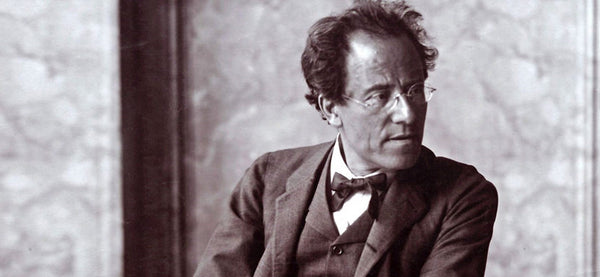
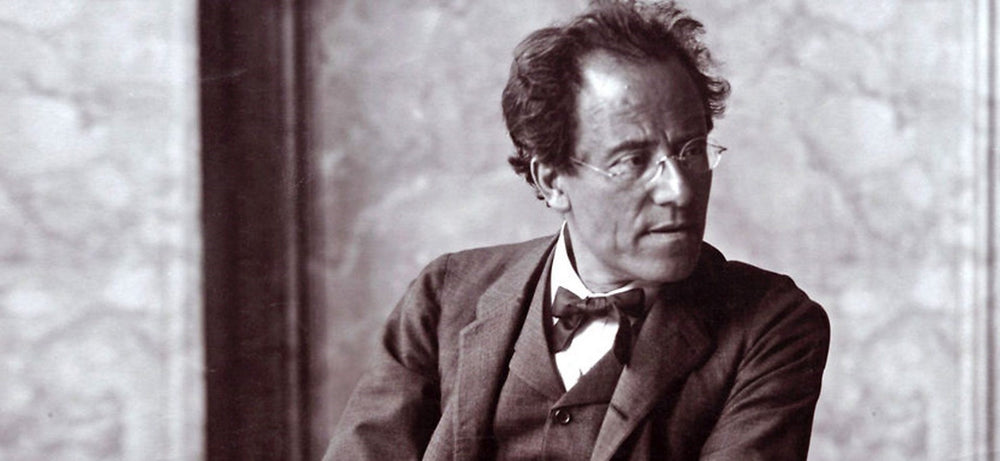
Why Collect?
Part 1: Adventures in Time Travel
Last week I unboxed a new vinyl-cleaning machine, plugged it in, flipped the on/off switches a few times. I knew the basics of LP care from using a previous machine, so the next steps were easy: select a record, give it a good wash-and-vac. One album had been calling out to me for quite a while: Giulini/Chicago SO/Mahler/Symphony No. 9 (DG, 1977), a two-disc box with a distinctive cover:
The disc surfaces looked okay, but I shampooed them anyway. Then I popped side A onto my turntable, and there it was: Mahler, played with plenty of heart by a great American orchestra, conducted by someone who knew how to maintain the crucial balance between passion and control. Together they offered a convincing vision of the Mahler of 1909, a composer who had spent a lifetime—literally!—learning how to transform personal narratives into symphonies and vice versa. Giulini and Chicago gave us not an exhausted, grief-stricken artist bidding farewell to life (an interpretation that became common during the Bernstein era) but rather a protagonist still in command of his energies yet now focused on ultimate, unanswerable questions. It was a well-considered performance in every respect, its engineers offering soundstage depth and imaging exceptional for that era.
I hadn’t exactly worn the grooves off this set over the forty-plus years I owned it. Considering my casual attitude toward record collecting, I feel fortunate just to have kept it around. Rediscovering it last week led me to ask other questions. For example: how in the world did Young Larry obtain the foresight to buy and hold something that would eventually mean so much to Old Larry?
Some backstory: in 1976 I was studying conducting at USC, so I got to attend certain rehearsals of the Los Angeles Philharmonic. The one I most remember was Carlo Maria Giulini’s final run-through of, yes, the Mahler 9. It was no ordinary rehearsal (we can safely assume that Giulini never ran an “ordinary rehearsal” in his life). They played the entire fourth movement without a break, and at the end the orchestra stood up as one and began to applaud. Not that thing where players discreetly tap their bows on a stand or shuffle their feet. No, they decisively put their instruments down and applauded. I can’t remember whether the handful of people in an otherwise empty auditorium joined in. We were probably dumbstruck at the sight of a hundred professionals actually thanking a conductor.
Anyway, I was not surprised when Giulini brought out a Mahler 9 recording, nor was I shocked to discover he’d done it with the Chicago SO, for which he served as permanent visiting conductor during the Solti era. Of course I bought the album.
Part 2: Actual Thoughts on Collecting
More backstory, but not as far back: I didn’t get serious about Mahler 9 again until well into the CD era. I recall acquiring Bernstein’s Berlin recording, and later Michael Tilson Thomas’s with San Francisco. This morning, I couldn’t find either on my shelves. I must have tossed them out after I heard Walter/Vienna PO/1938 (Dutton CDBP 9708), a truly historic and far more lyrical, less labored performance. In 2009 Alan Gilbert turned in a high-res performance in a similar vein with the Royal Stockholm PO (BIS-SACD-1710). I’ve kept those discs, along with an NY PO box, The Mahler Broadcasts, which includes Sir John Barbirolli’s 1962 live performance. I’m looking forward to hearing that one again.
It’s not that I became an antiquarian—although once you’ve heard, say, Barbirolli’s recording of the Enigma Variations, it does become harder to sit through Andrew Litton’s very-nice-but-hardly-transcendent reading. It’s more that collecting records is a Sisyphean struggle. You can’t always get what you want, largely because what you want is subject to change for various reasons, among them:
You grow up, and your tastes (values, preferences, desires, etc.) grow up too. Or at least they change.
Technology changes, but the ways in which you adapt (or fail to adapt) may vary.
You lack the money or the shelf space to indulge all your whims (values, preferences, etc.).
The phenomenal growth of high-resolution streaming has now produced a whole new set of issues for the collector. Foremost among them: why collect at all? If I can hear almost any recording of a work ever made—or at least the fifteen most popular and/or critically acclaimed recordings of that work—what’s the point of paying more to download certain items? How do I choose what will reside “permanently” on my household hard drives? Should I hang onto my CDs? My LPs? My lifelong itch to buy something?
Lastly: who will get my collection when I’m gone? Who will even want it?
I think I know what works for me, at least this week, this month. More than ever, it’s a work in progress. How’s it going for you?
(This column was originally titled The Accidental Connoisseur and included another 900 words about Mozart’s La clemenza di Tito. We’ll get back to that.)
Header image: Gustav Mahler, etching by Emil Orlik, 1902 (Wikimedia Commons)

